Tuscany, Italy is a vision of rolling golden hills dotted with cypress trees, olive groves and vineyards. The picturesque, verdant valley that includes the Orcia river (which it is named) spreads through the Siena and Grosetto provinces and is known as the Val d’Orcia. Here are towns to visit in Tuscany.
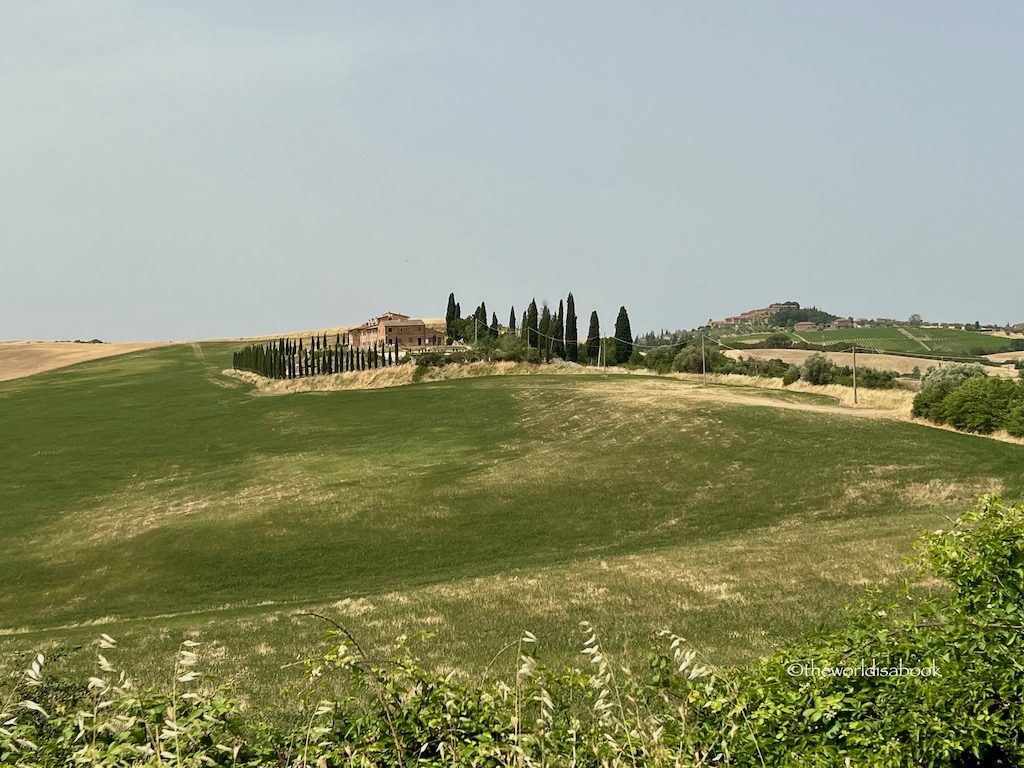
We spent a few days exploring the Tuscan area last summer. We highly recommend renting a car. Yes, driving in Italy’s country side can be a bit nerve wracking with small winding roads and those Italian drivers that get right up to your bumper and tail gate. Pack a bit of patience since it’s all worth it despite everything.
These are some of the attractions and towns we visited during our five-night stay. This also shows our itinerary and how we grouped the towns for each day. This whole valley is a UNESCO World Heritage site and you will be in the middle of it all.
Siena
We used Siena as a base to explore the nearby Tuscan towns. This beautiful town is a UNESCO Heritage site and one they recognized as “the ideal embodiment of a medieval city”.
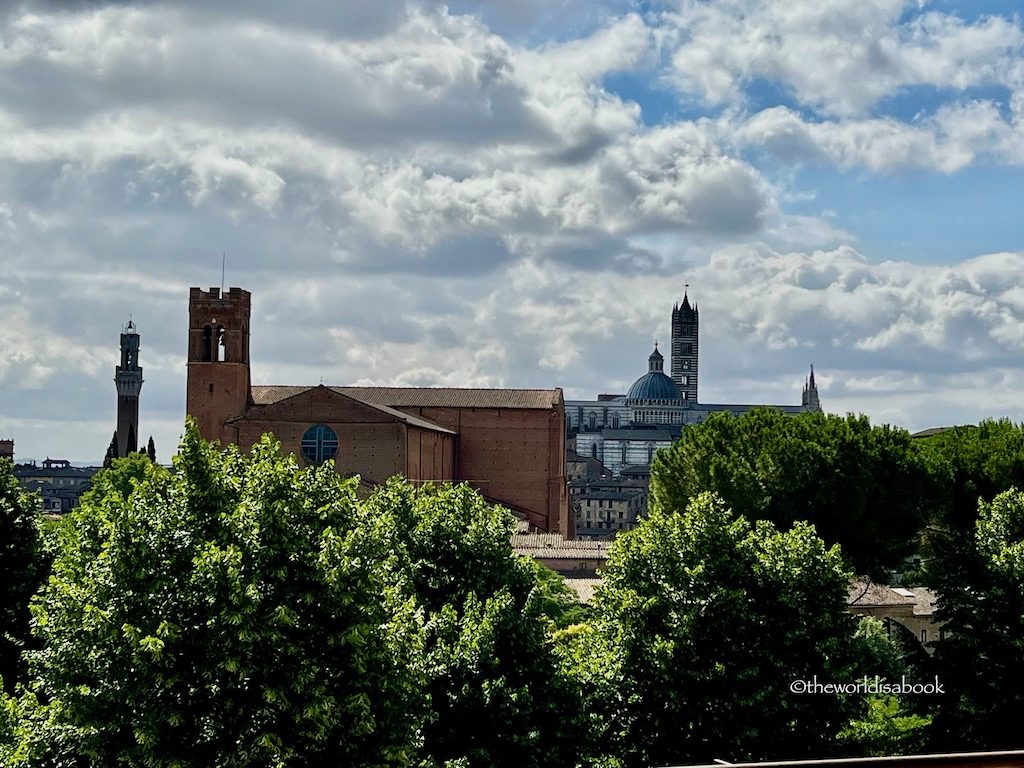
Twice each summer, Siena holds the medieval-style, bareback Palio horse race in its main square, for which it is well-known.. The dates are usually in early July and mid- August.
Each horse and jockey represents various contrade or districts/neighborhoods with their own colors, flags and animal emblem. We loved walking through the decorated streets and seeing the differences between them.
I can write a whole post on the things to do in Siena but will touch on the highlights here for now.
We missed the actual race by a few days in early July. But, we got to see all the preparations including the parades of the colorful districts and the trial runs. It was quite an experience to see the square filled to the brim with people.
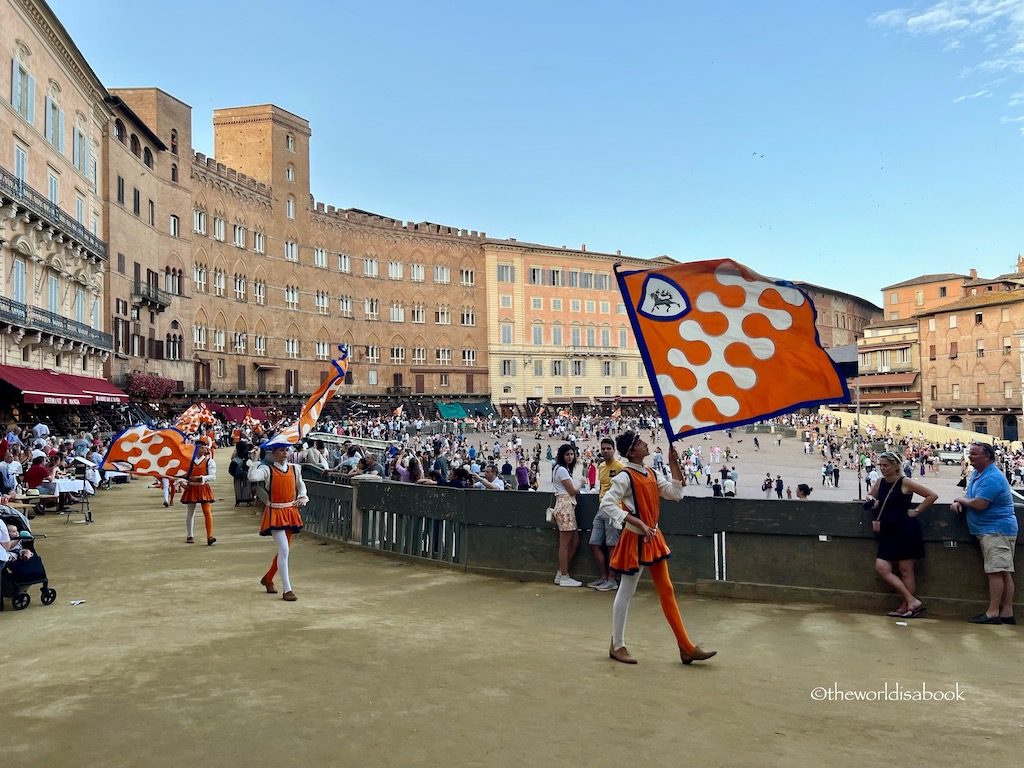
And it was so fun to come across so many celebrations of neighborhoods eating, gathering and singing. I can’t imagine visiting Siena at another time without all these activities.
One of the great things about staying overnight in towns that are popular with day trippers is seeing the contrast with crowds between day and night. We really enjoyed exploring Siena’s quieter streets at night.
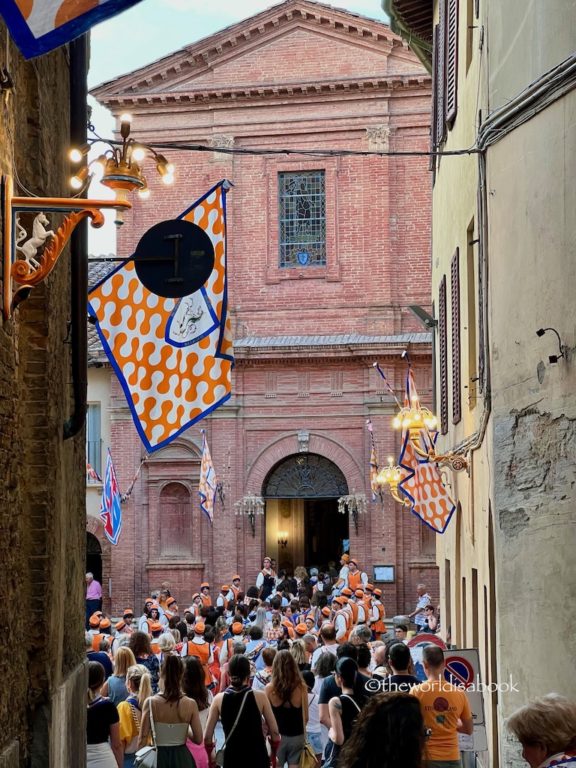
The Piazza
Piazza del Campo or il Campo, Siena’s main square, was one of the most beautiful and unique squares we’ve visited in Europe. It almost looked like a shell with a hemicycle or semi-circular shape.
“Fishbone-patterned” red bricks, divided by 10 white travertine, bands dominated the ground pavements. There are 11 passages throughout the piazza. Former private palaces surrounded the square.
The 14th century Torre dell Mangia dominates the area and symbolized freedom from the feudal power. The terracotta colored tower is 102 meters tall (335 feet). Visitors can climb 400 steps to the top of the tower. Combine tower tickets with the civic museum and the Santa Maria della Scala.
The tower was named after its first bell-ringer Giovanni di Balduccio. He was well-known as Mangiaguadagni (earnings-eater) or Mangia for short since he squandered money.
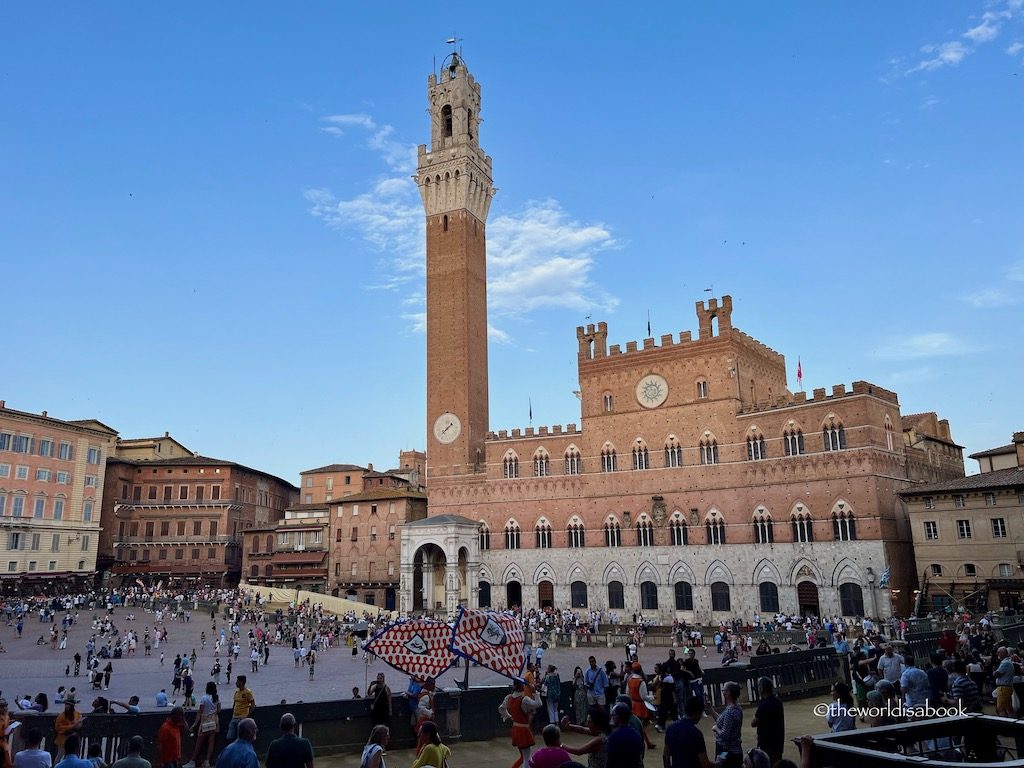
The brown and orange buildings surrounding it were beautiful and blended well with the ground and with each other. In the 13th century, architects created guidelines before constructing the buildings to ensure they built them cohesively and uniformly and blended well together with the piazza’s image.
Builders constructed the piazza at the intersection of Sienna’s three main roads, with the intention of making it the center of everything. It has been the site of countless celebrations. Since Palio festivities were happening during our visit, we saw the square filled to the brim with people and parades around its perimeter.
We also enjoyed coming here at night when there were hardly any people. It was wonderful to sit on the square, enjoy looking at the glow of the buildings and watch the activities. If you’re visiting during the summer, it was also much cooler at night so this was a wonderful place to hang out.
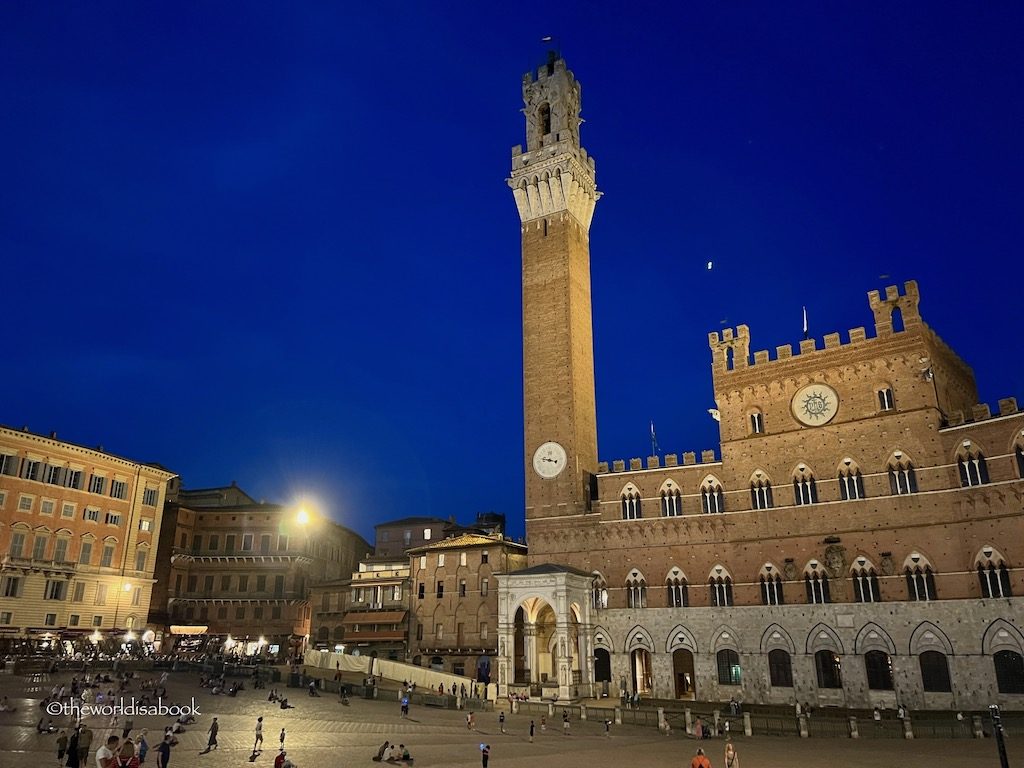
Duomo of Siena
The other cannot-miss attraction is the Duomo in Siena. It dominates the skyline of the city since it is located on the highest point on Piazza del Duomo. I’ve visited many churches and cathedrals all over the world and this has become one of my favorites and truly one of the most beautiful.
The 13th century Romanesque-Gothic cathedral is shaped like a Latin cross with a huge dome and bell tower and was dedicated to the Virgin Mary. The alternating white and green/black marble stripes is common in its exterior and interior.
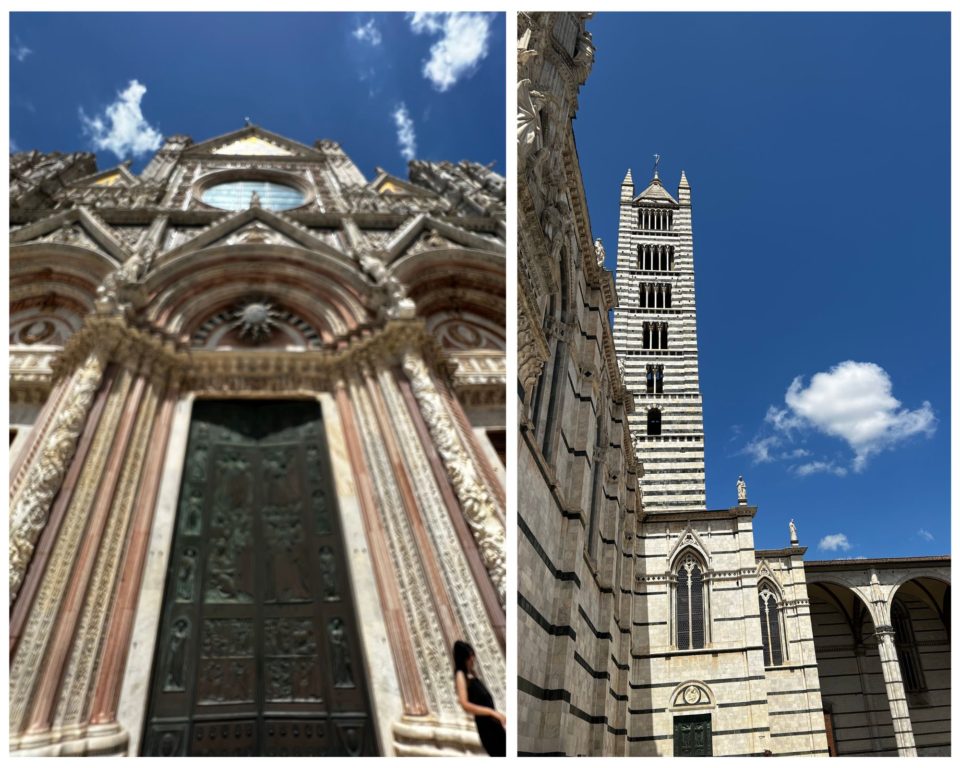
Take some time to walk around and admire the cathedral’s pink, green, white marble exterior and the incredible details and statues. If you need some place to rest, there are steps behind and seating on the side.
The interior
Marvelous details filled the exterior and was quite a masterpiece. Buy the ticket to explore its magnificent interior.
It was mesmerizing to see the artwork, details, colors and tall striped arches and columns once we entered. But, the most incredible and impressive parts of this cathedral were actually at our feet.
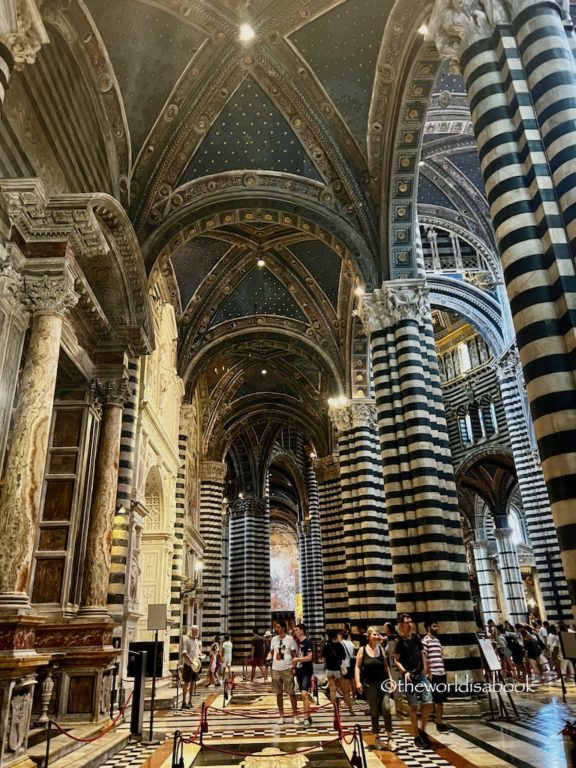
Siena’s cathedral had the fanciest and most detailed floors we’ve ever seen. About 40 of mostly artists from Siena, between 1369 and 1547 during the Renaissance era, designed 56 marble panels.
It took almost six centuries to complete these mosaic panels using various techniques. They tell a variety of stories from the Old Testament.
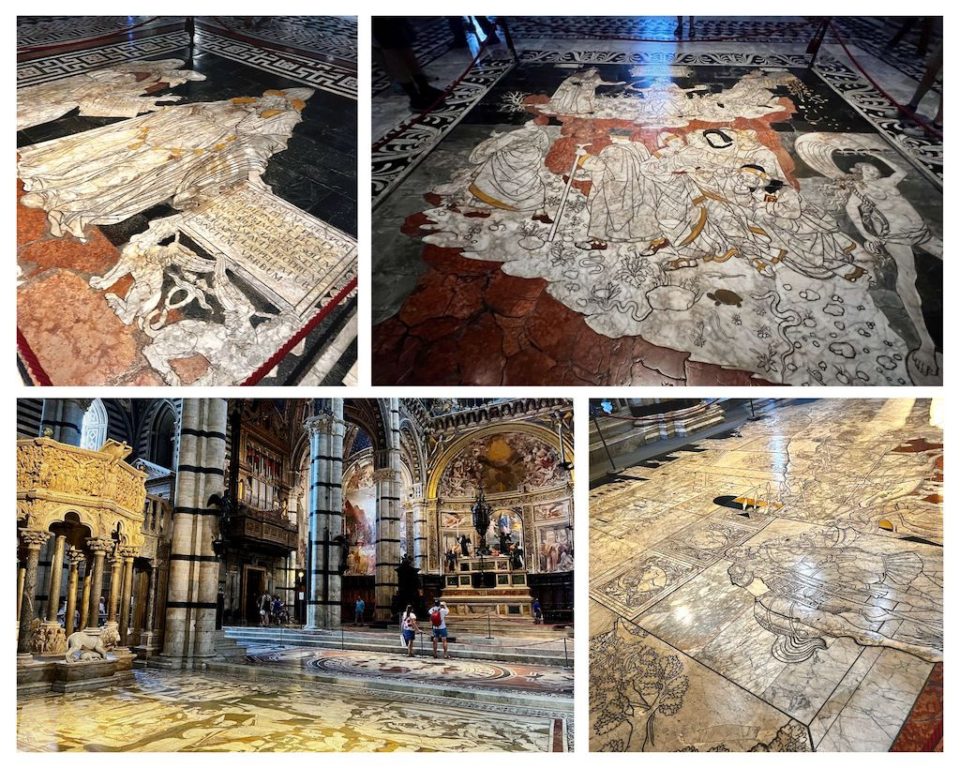
The Piccolomini Library
There is so much to explore inside this cathedral but we highly recommend going into the Piccolomini Library which is a small room. This library was dedicated to Pope Pius II and was meant to house the pope’s vast collection of manuscripts.
This library was small but its walls and ceilings were filled with well-preserved frescoes by Pinturriccio. It was hard to believe that these paintings have been around for centuries and how vivid the colors still looked. There were some manuscripts on display there too.
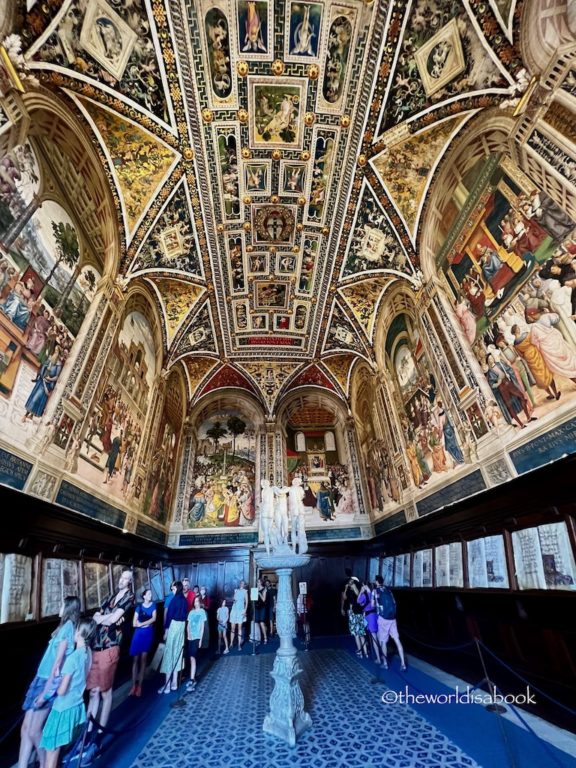
The walls depicted ten important scenes from Pope Pius II’s life. The details were astonishing and it will definitely make you want to know more about him. Don’t forget to also look up at the masterpieces on the ceiling.
Duomo Tickets
Try to buy your tickets ahead to avoid the lines. This is Siena’s most famous attraction so expect crowds. The Opa Si Pass ticket allows entry to all the complex sites including the cathedral roof, baptistry, crypt, etc. and is valid for three consecutive days from the date of purchase. Buy tickets here.
Guided tours are available but tickets also come with a free audio guide for a self-tour. Allow at least two hours to explore and enjoy the beauty of the cathedral.
Please follow the cathedral’s dress code. Shoulders and knees should be covered. Pack a shawl or pashmina to wear inside here if you’re visiting during the hot summer months. Mass at the cathedral is on weekdays at 10 AM if you want to attend.
The Weekly Market
One of my favorite things to do when exploring cities is visit their local markets. It is such a wonderful insight into the lives of the locals. Siena didn’t disappoint. The city holds a weekly market every Wednesday from 8:30 AM to 1:30 PM at Li Lizza park and around the Fortezza.
This outdoor market was filled with a variety of vendors selling fruits and vegetables, flowers, household items, bags, shoes and clothes, etc. The prices were very reasonable especially for clothes. This was a huge market and looked overwhelming at first glance. There was also an area to try out some local foods.
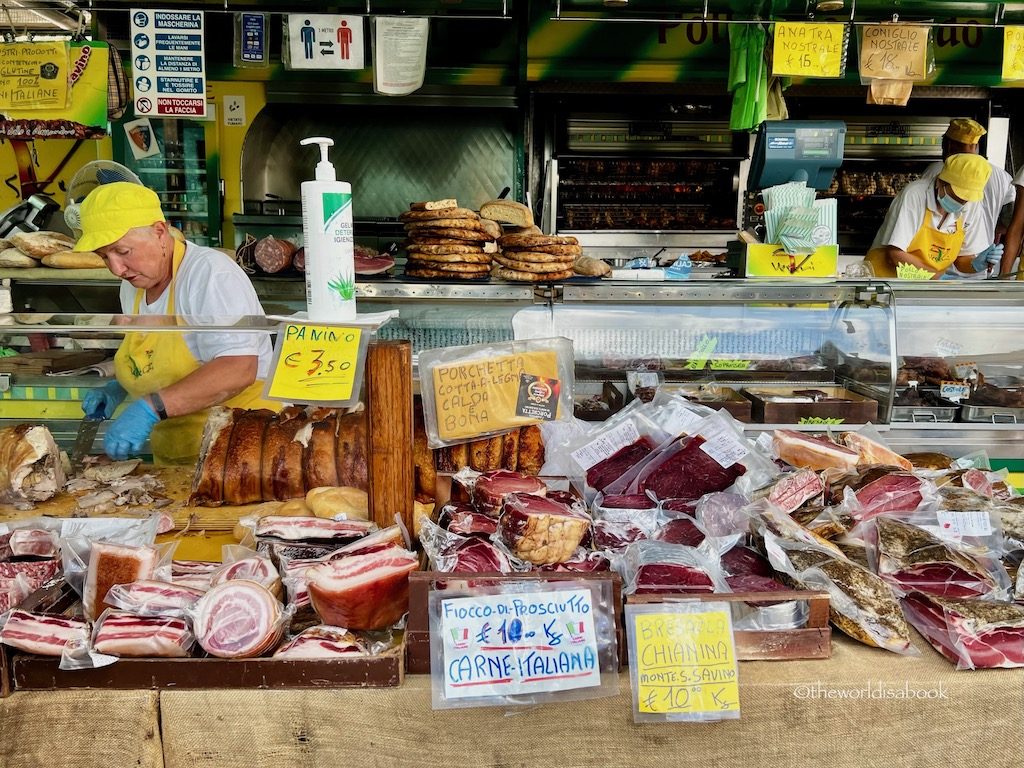
Don’t miss going inside and around the Fortezza. There is a great panoramic view of the city from here. It has very nice green and spacious areas for resting especially under the summer heat.
Where to Eat
There was no shortage of a variety of restaurants in Siena. We ate at two great Michelin star restaurants and they were such wonderful values.
Osteria Babazuf – This newly-minted Michelin restaurant was located in one of the side streets. We enjoyed eating outdoors and watching all the activities here during our dinner. Their food was delicious and some of them included mushrooms and truffles. My son really loved the octopus dish and my husband enjoyed the tagliatelle with mushrooms.
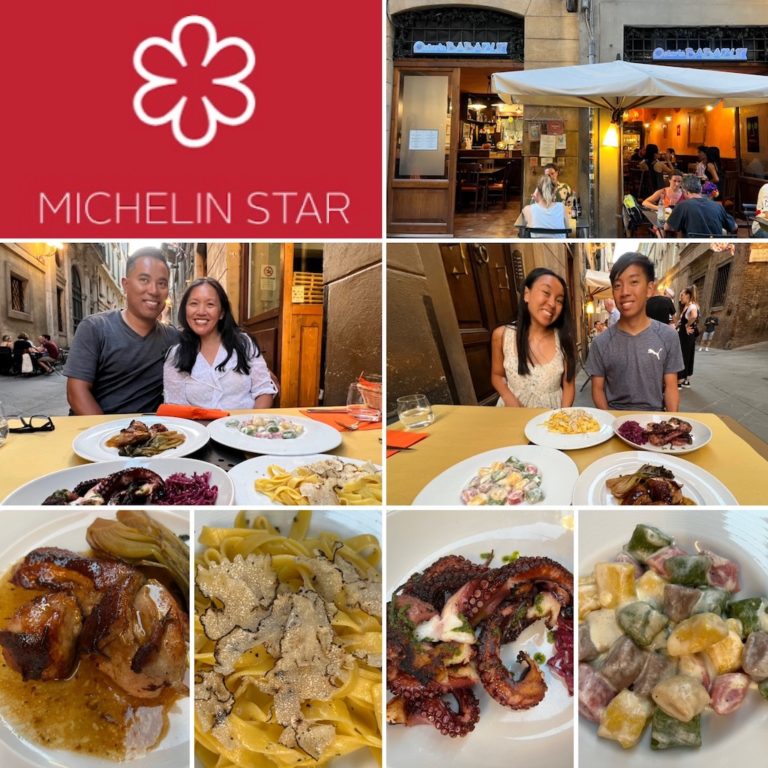
Osteria Permalico – This highly rated restaurant with so many wonderful reviews on many websites are all justifiable. Located in the heart of the historic center, there were some outside seating but with the summer heat, it was very nice to sit indoors in what looked like once was a cellar.
Many pasta dishes were less than 10 euros with good portions. We did not have a reservation but they were able to accommodate us. However, we saw many other people turned away as it got later so make a reservation. We recommend their cacao e pepe and pici aglione.
Zest – One of our best meals on this trip was at this restaurant. We totally understood why it earned its Michelin ratings for many years. Seating was outside precariously by a steep sidewalk but had some wonderful views of the historic center.
Our dishes were all under 20 euros. I loved my seafood pasta and my husband really enjoyed his salmon risotto. We highly recommend their tiramisu – seriously, one of the best we’ve ever tried.
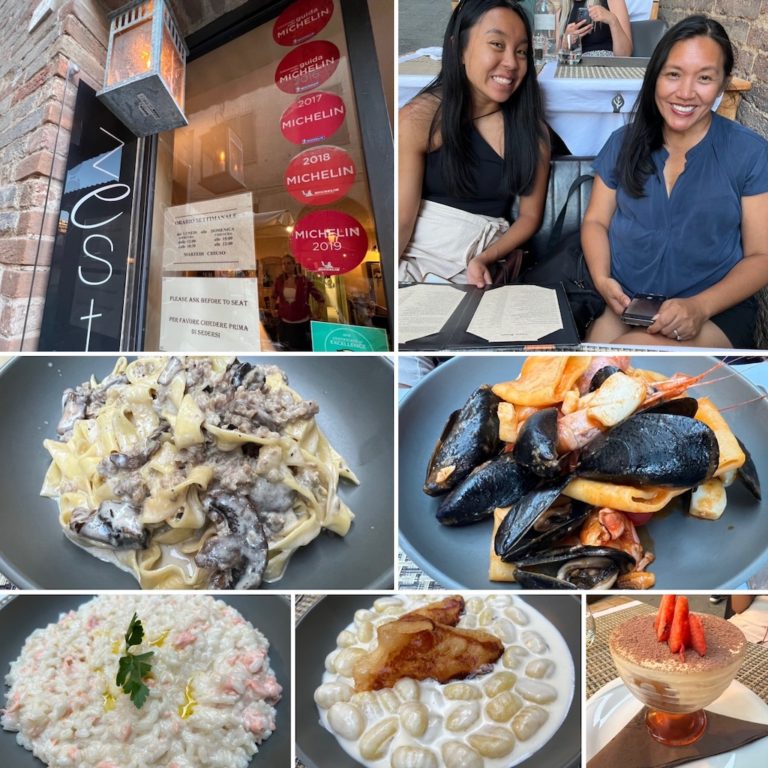
San Gimignano
We spent an afternoon at this very memorable hilltop town. Known as the “Manhattan of Tuscany”, the town can be seen from miles away with its distinctive towers. This UNESCO World Heritage walled city was certainly unique compared to the other Tuscan towns.
San Gimignano’s rich families built several tower-houses as symbols of their wealth and power during the 14th century. Families usually built one taller than the other to compete against each other. It was a lot of money and resources to build a tower.
There were conflicts within the town and between families and even legends of young lovers who secretly met who came from feuding families. Yes, like Romeo and Juliet but with Tuscan towers.
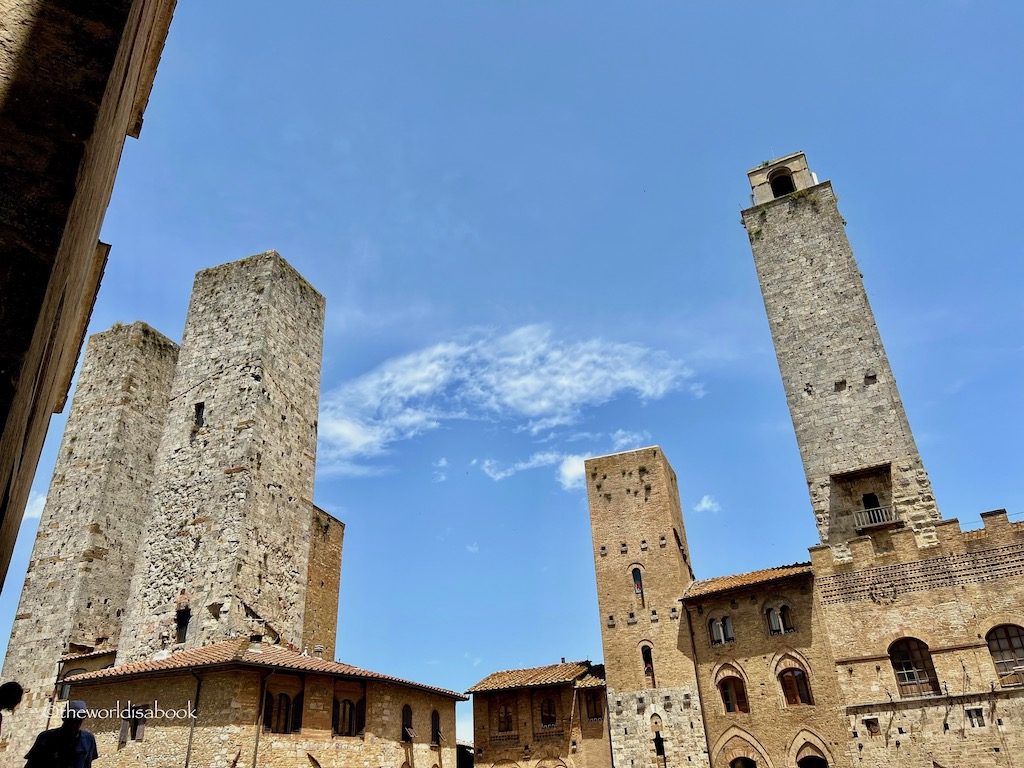
At one time, there were 72 tower-houses here. Some were as high as 164 feet (50 m). It would have been quite a sight to see these towers from the distance. With time and the elements, only 14 towers currently survive. The tower houses were used as dwellings in addition to workshops.
We enjoyed walking around here, marveling at the amazing medieval buildings and looking up at the towers. The town name is believed to have come from Modena’s bishop and saint. Legend says the saint miraculously appeared on the city walls and saved the town.
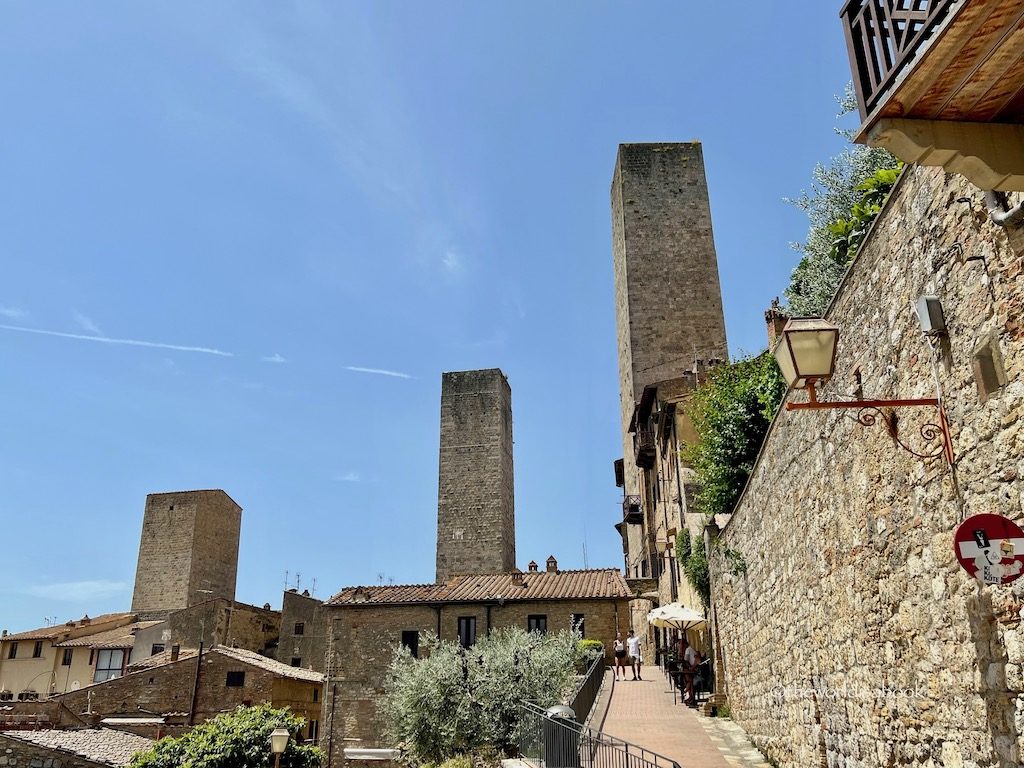
Piazza della Cisterna in San Gimignano
The town has two main squares filled with important towers and historic buildings. The first one we went into was the triangular shaped (with a bit of a slope) Piazza della Cisterna. We entered this square through the l’arco dei Becci (Arc of Becci), which was the ancient city’s gate. The Torri dei Becci (Tower of Becci) and the Torri dei Cugnanesi (Tower of Cugnanesi) flank both sides of the arc.
The beautiful piazza was surrounded by noble houses, former palaces and medieval towers with the ground floor areas now occupied by shops and restaurants. This was the cultural center of the town for centuries and was the site of markets, public performances, festivals and tournaments.
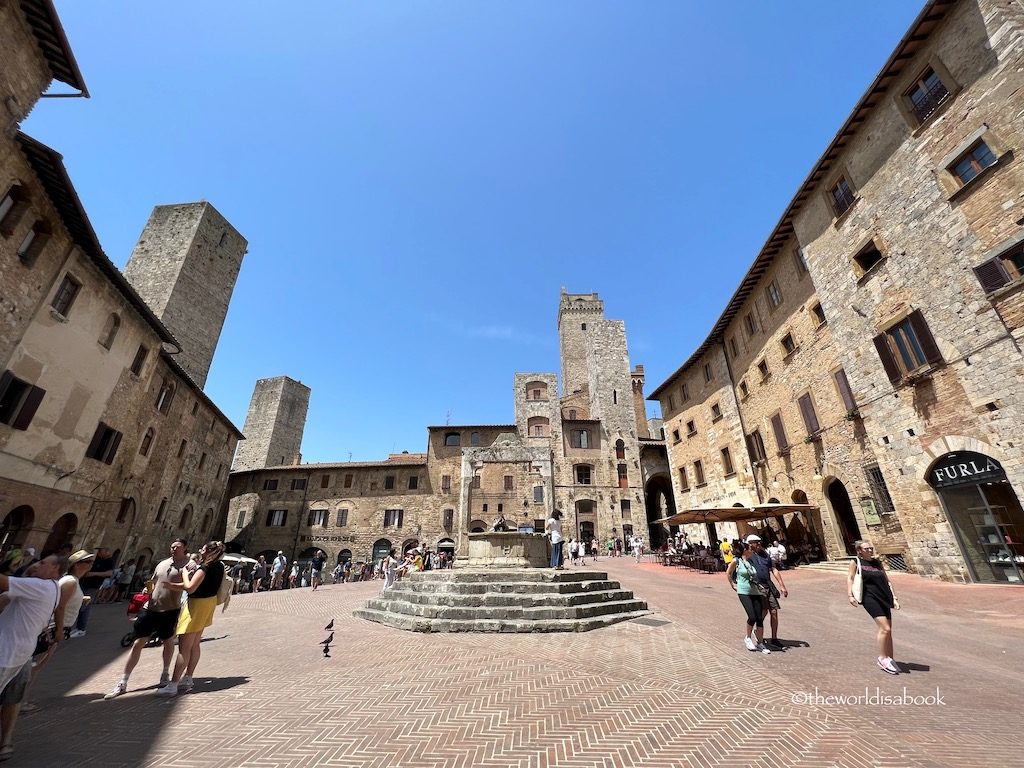
I loved how you could really see the various towers surrounding this square. Most of the Medieval and Romanesque structures have been restored here including the brick paved ground. It almost felt like we stepped back in time.
There was also the Museo Criminale Medievale or Criminal Medieval Museum which is within the Piazza della Cisterna. This unique museum shows various exhibits on crimes and punishments during the Medieval Ages. Interestingly, there were also some torture museums on the main street here.
This square, which is actually shaped like an inverted triangle on a slope, was named after the water cistern with an octagonal base that still stands today. San Gimignano was a “relay point” for many pilgrimages who traveled to and from Rome using the Via Francigena road.
Piazza Duomo in San Gimignano
The other main square here was Piazza Duomo. This dates all the way back to the 13th century and flanked by several towers too. This piazza was the religious and political center of the city as the site of the cathedral.
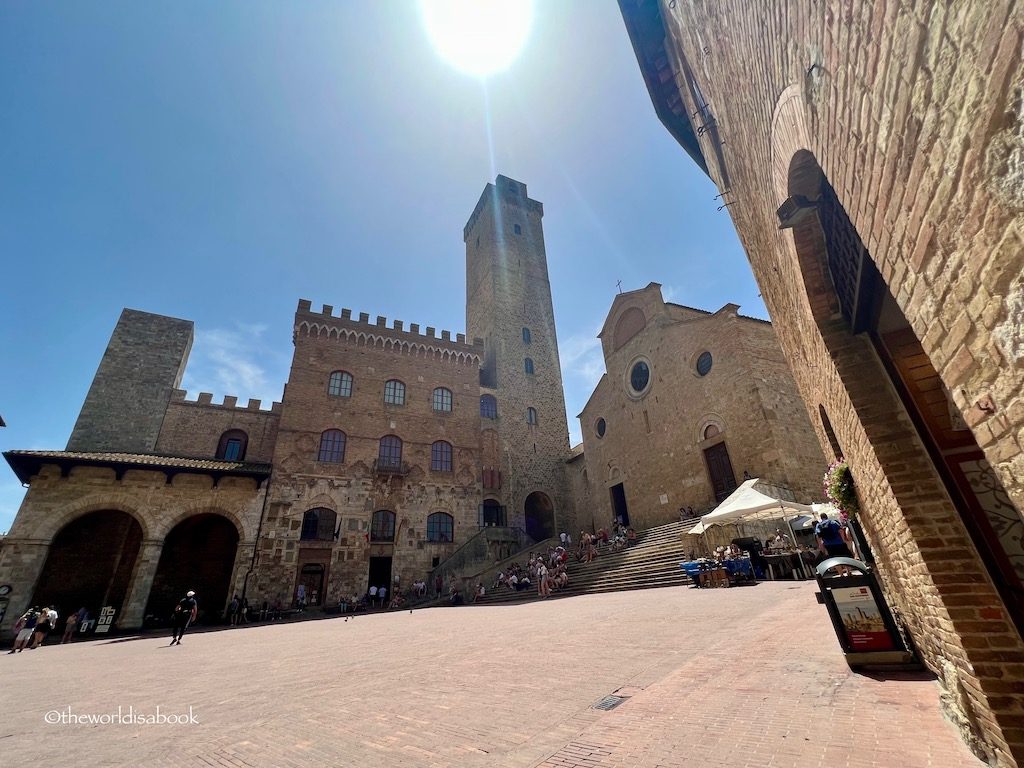
We enjoyed sitting on the steps here and admiring the various palazzos across from it. Their facades were beautiful. Visitors can also go inside the Duomo.
The Torre Grossa is the town’s tallest tower at 177 feet (54 meters) followed by the Torre Rognosa (52 meters) which is next to the Palazzo della Podesta. Visitors can go up some of these towers for panoramic views of the countryside. Sunset watching is quite popular atop Torre Grossa.
We followed the road from Piazza Duomo that went downhill and ended up at a road. There were several lookout points here to admire the countryside. We recommend and enjoyed walking back to the piazzas using some of the smaller side streets.
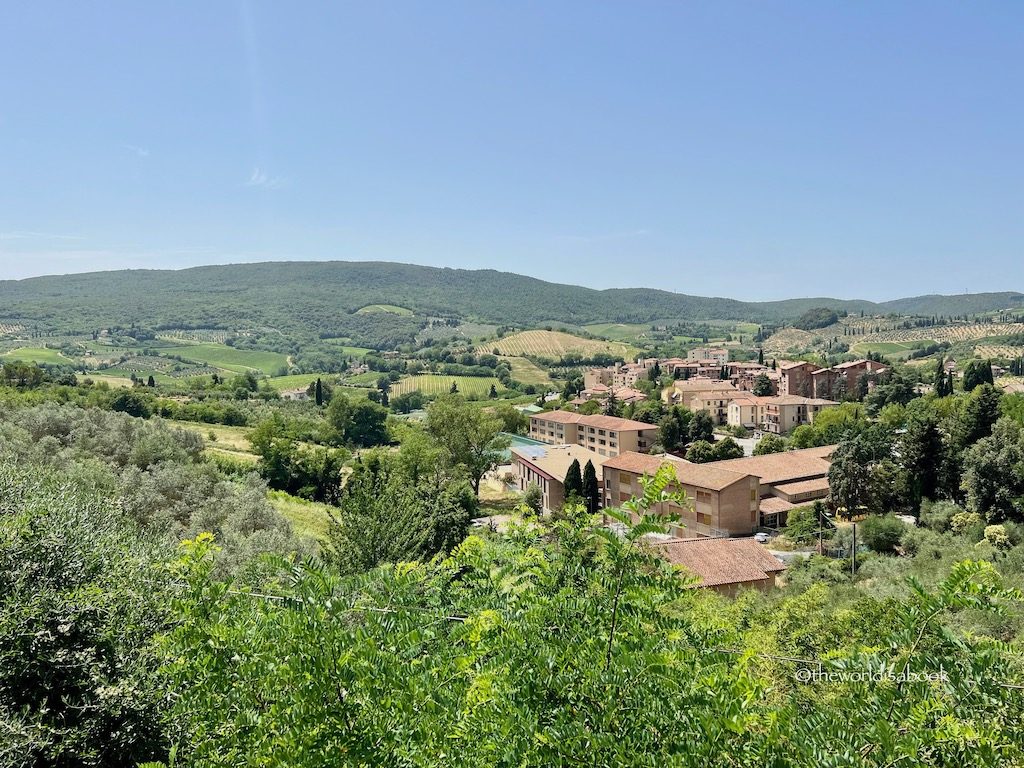
Shopping in San Gimignano
Some of my favorite shops here was Tinacci San Gimignano. Go inside and downstairs for some amazing collection of pottery, ceramics, linens and souvenirs. I wish my shopping budget was a little higher to take many more of these unique items home.
Don’t miss stopping by Nino and Friends for some chocolate samples and some delicious candies, chocolates, cookies and other goodies. There was also a mouth-watering fountain at the entrance.
We were here during the busy late June summer weekday. It wasn’t as crowded as we expected. After we veered off from the main street and the two main piazzas, we found many quiet streets to explore. But, if you’re visiting at the height of a summer weekend, try to get here before 10 AM or after 5 PM when most of the day trippers have left.
Parking can be tough closer to the gates. But, there were plenty of spaces down the hill from the main gates. It just required some walking uphill beforehand.
If you can get here by public bus, many drop visitors right at the Porta San Giovanni entrance across from the Piazzalle Montemaggio. We actually enjoyed walking through this small green space with historical statues and several benches for relaxing in shaded areas.
Where to Eat
There were several restaurants around the town and some were on the piazza that were great for people watching. While there were others that offered great panoramic views. Local products, like saffron and the Vernaccia di San Gimignano (a white wine), are common here.
We went with a restaurant that offered outdoor seating and had a vast menu. La Biscondola was located on a side street near one of the towers before walking into the arch. We had several kinds of pasta and they were all delicious. Try any of the pici pasta dishes.
My kids’ favorite spot in Piazza della Cisterna was also the one with the longest line during a hot summer day. The very popular shop is the award-winning Gelateria Dondoli and mentioned in many guides around the world. After trying their gelato, we could see why they constantly had long lines.
Their special flavors seasonally vary but they use the most local ingredients. During our visit, it was Cream di Santa Fina (Cream with San Gimignano saffron and pine nuts), Rosemary Baby (raspberries and Tuscan rosemary) and Michelle organic (almonds and saffron). Visitors can also take gelato making classes here.
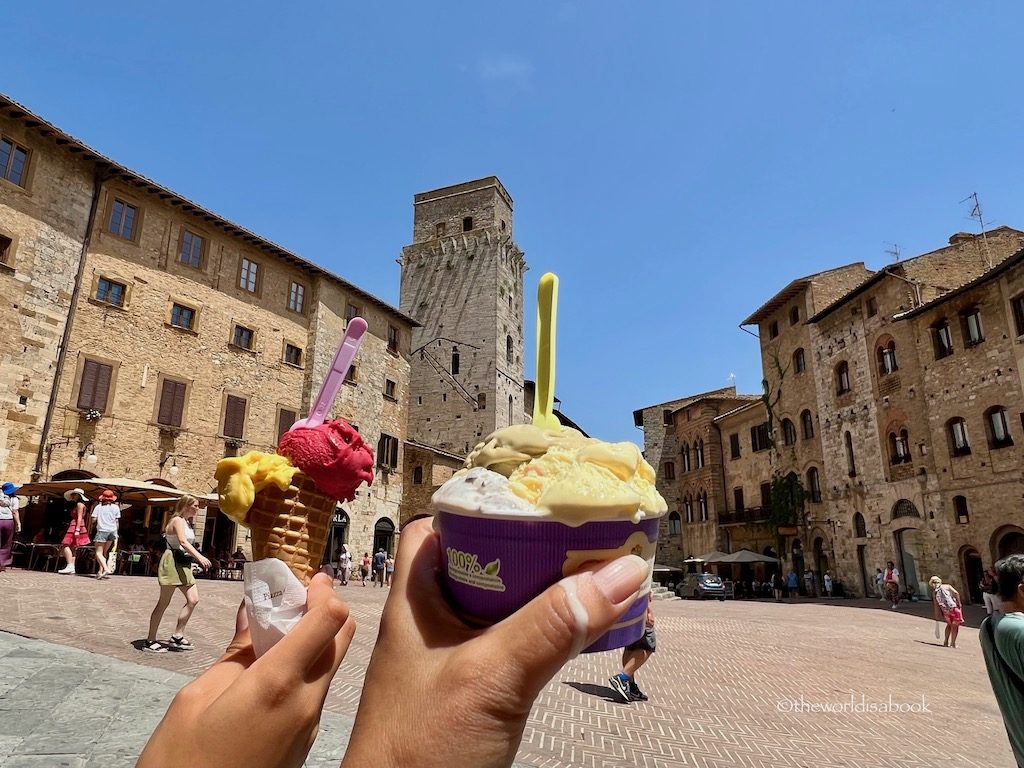
Day 3: Hot Springs and Montalcino
We started this day of sightseeing by finding the lookout for that iconic Tuscany postcard view of a winding road lined by cypress trees amidst the golden wheat fields. Agriturismo Baccoleno is the structure at the end of the road. We followed the coordinates which my husband found online. Use this: Punto panoramico crete senesi agriturismo baccoleno – 43.1993934, 11.5889608.
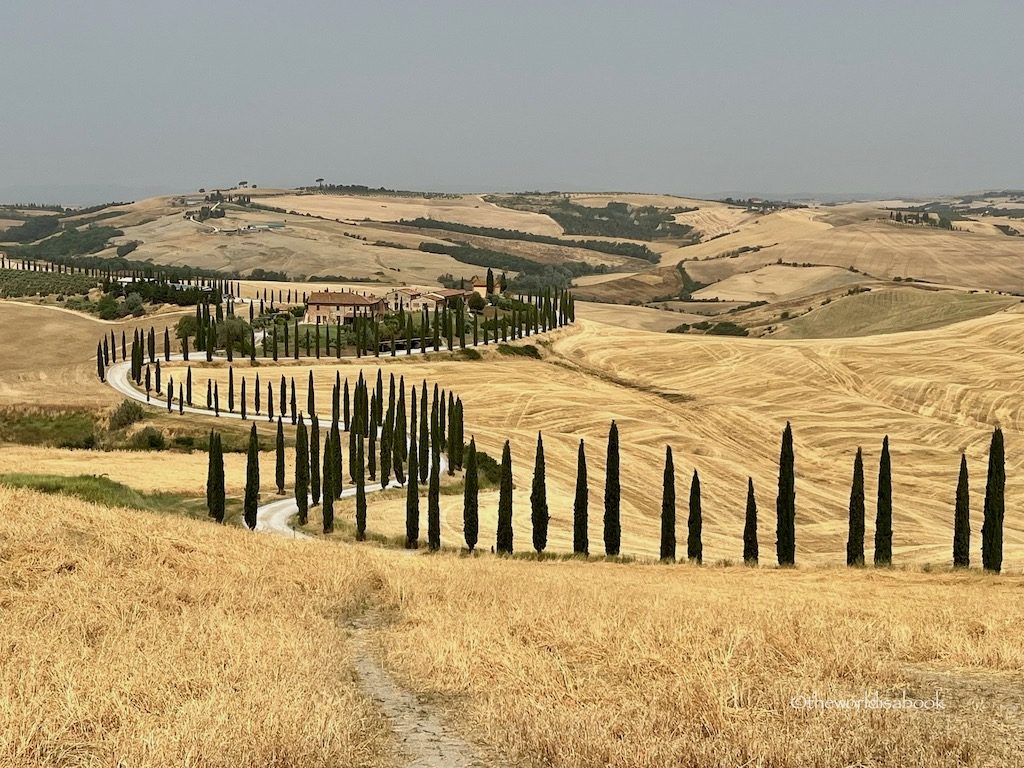
There were actually parking spaces and a clearing on top of the hill to take photos. It was a beautiful panorama. If you’re here during the summer, there is no shade so it was very hot. Please keep in mind that this is a private property.
Bagni San Filippo hot springs
Most articles will direct you to the Saturnia Hot Springs if you type in Tuscany hot springs. Saturnia looks amazing with its multi-level water cascading. But, it was going to take us almost two hours to get there. It also gets very crowded as its popularity has risen thanks to vloggers and social media influencers.
As an alternative and one that’s not too popular just yet but also an amazing place to visit is Bagni San Fillippo. It’s free to enter and you spend as much time as you want here with hardly any crowds. This small town was located about 35 minutes from Montalcino.
Getting to the Hot Springs
There was no parking lot to the springs and the town was quite small. Though, we knew we were near the springs with the pungent smell of sulfur in the air and the sound of river flowing. Parking was not free and it was along the street. There were machines to pay for parking along the street.
We walked a short distance through a dirt path amongst a lush vegetation and under a canopy of trees and eventually came upon this scene. Located in the middle of the forest, it was a cascading stream of white and blue water with white calcification along the sides. There were little pools that looked like they were sectioned off separately.
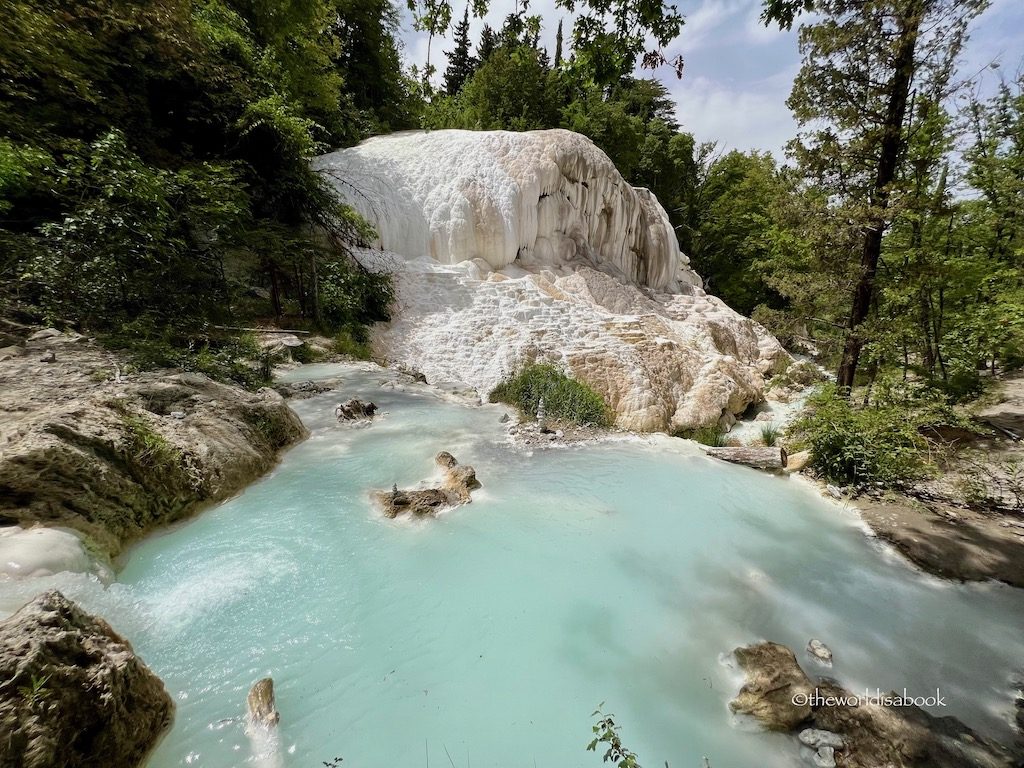
There weren’t that many people here during our visit in the morning. My family had our own private pool and we loved feeling like we were in an outdoor spa. The water was very warm. There were small waterfalls that ran off some rocks that felt like massagers. It’s no wonder the Romans and Etruscans considered these healing waters.
The pools were wonderful places to sit and relax. The surrounding forest of towering trees and lush vegetation really added some ambience
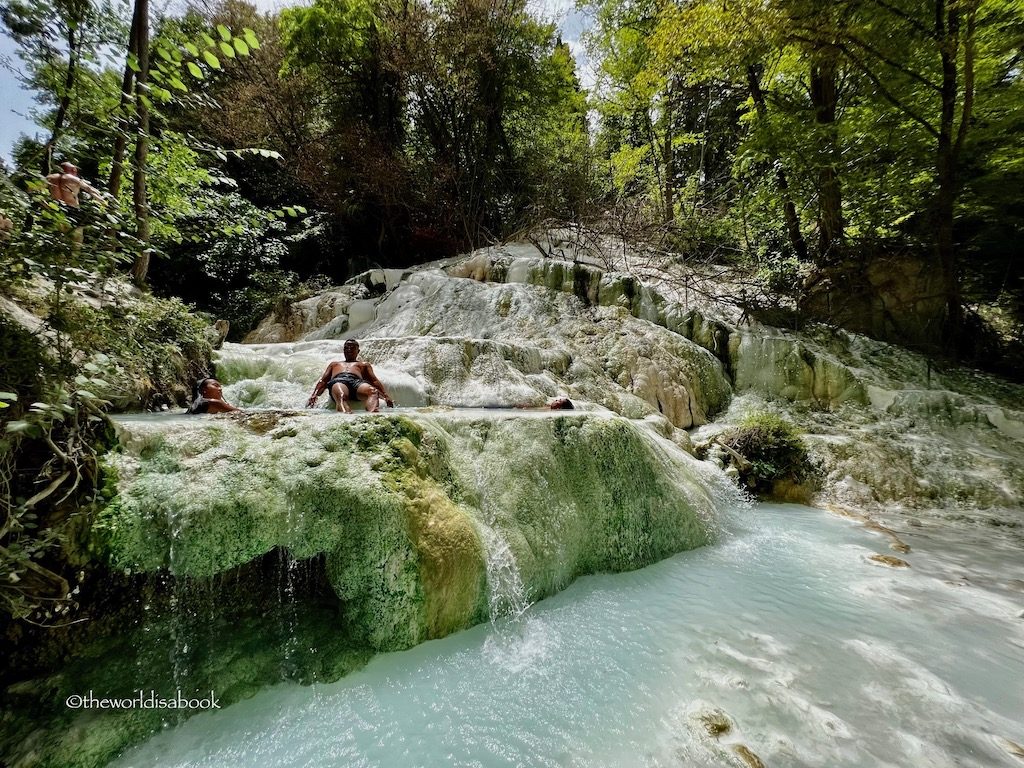
The springs flow down the river but we didn’t venture further. The highlight here was the large, white, calcified waterfall formations called “la galena blanca” or the “white whale”.
This was such an amazing and unique sight. Some parts of the pools had white calcified matter or “thermal mud” at the bottom to use for body and face masks for smoother skin and help with some ailments like eczema.
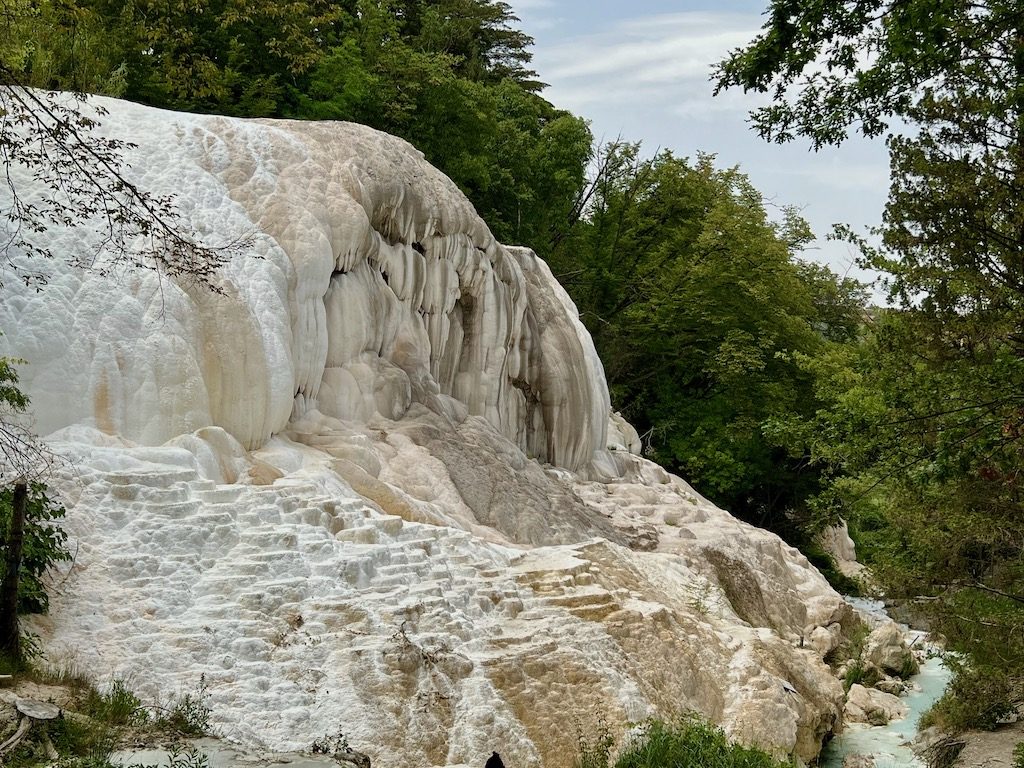
Bagno Vignoni
We made a quick stop in another charming and unique town called Bagno Vignoni. It was only about 18 minutes from the Bagni San Filippo hot springs.
Unlike all the other Italian towns, Bagno Vignoni’s main central square was entirely occupied by a large pool of natural hot springs water. The Renaissance-era piazza was built directly over the original source of hot springs the way the Romans did a long time ago.
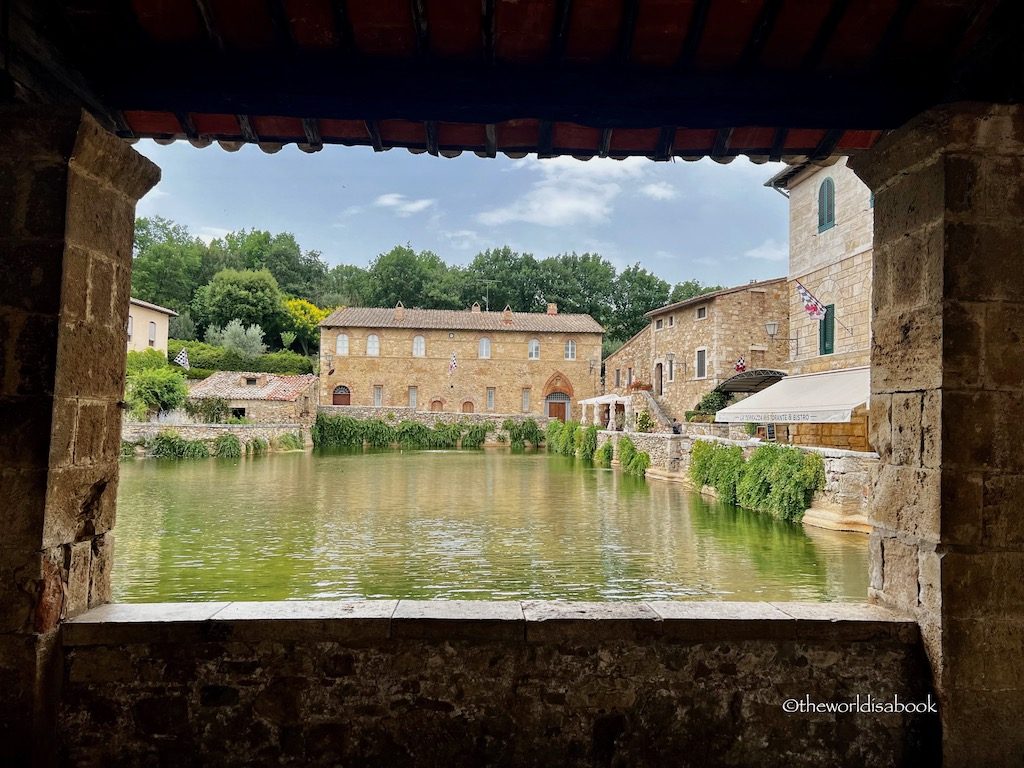
The Romans and Etruscans who lived in the area enjoyed using the hot springs for bathing, cleansing and also for medicinal purposes. Bagno Vignoni is near Via Francigena which was a major travel route that many pilgrims used to travel from England to Rome and Jerusalem. According to many accounts and from travel journals, many of these pilgrims stopped here to use the hot springs.
The Hot Springs of Bagno Vignoni
Bagno Vignoni’s hot springs are considered the hottest in the Tuscany region at about 125 F(52C). The high temperature waters are also filled with rich minerals that are good for the skin and for helping with ailments like arthritis, osteoporosis and muscle cramps as well as helping relax the muscles.
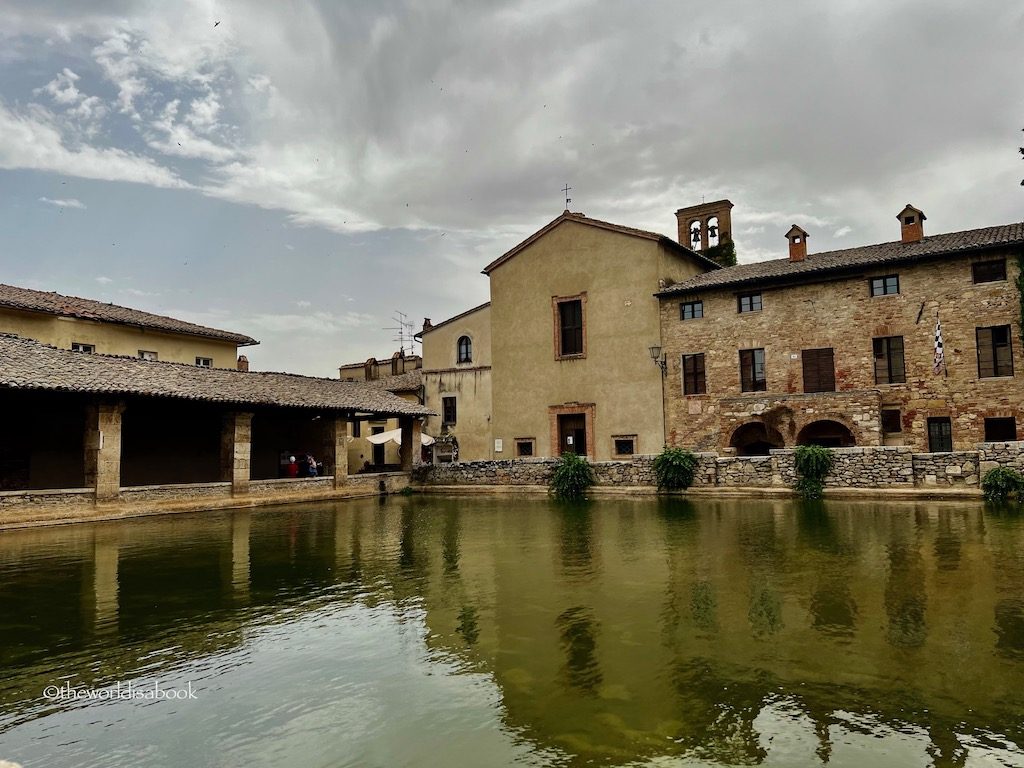
This pool is in the main square is not for bathing though. The town has several spa centers and hotels dedicated to thermal baths and treatments. Check out Santa Caterina which is right next to the main square.
The other popular ones that cater to visitors are Adler Spa Resort, Thermae, Hotel La Terme and Hotel Posta Marcucci. I wish we could have stayed here longer and sampled some of what the spa centers offered,
It was a very walkable and charming town. There were a few stores and cafes here. There was a free outdoor hot springs below the main area of Bagno Vignoni. You can follow the small canals on the left of the main square and down hill to a pool. Unfortunately, we didn’t get to explore this particular pool.
Montalcino
We spent the rest of our day in the fortified and medieval town of Montalcino known as the home of the world-famous Brunello red wine. The drive to this medieval town was beautiful with rolling green valleys dotted by many vineyards.
We started our tour of Montalcino on one of its most popular attraction – the citadel or fortress. There were paid parking spaces right outside the gates of the citadel.
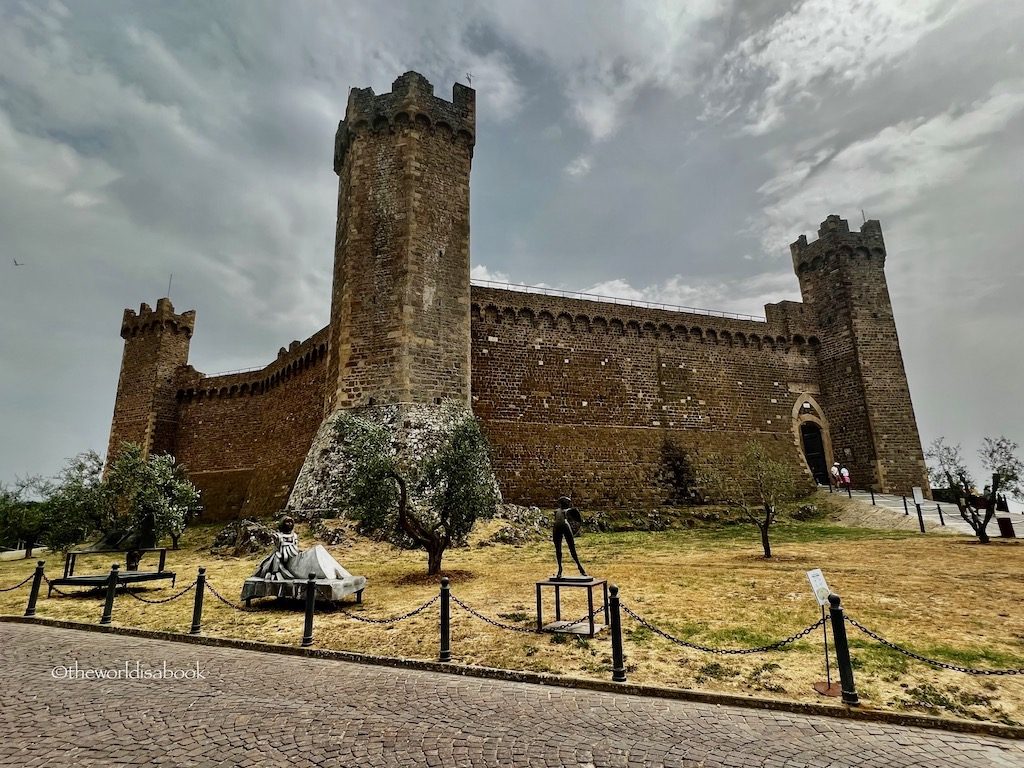
The Fortress
Builders constructed Fortezza di Montalcino, an imposing structure, in the 14th century to ward off foreign troops and invaders. The fortress underwent restoration in the 1940s. This is great venue for many events. Tourists enjoy exploring this wonderful place and seeing panoramic views of Val d’Orcia from the top.
The Enoteca La Fortezza, a wine shop, is also located inside the fortress. We enjoyed walking around the fortress and on its ramparts.
The big open space in the middle was the ideal place for smaller kids to expend all that energy. There were also several interesting and beautiful female sculptures outside the fortress during our visit.
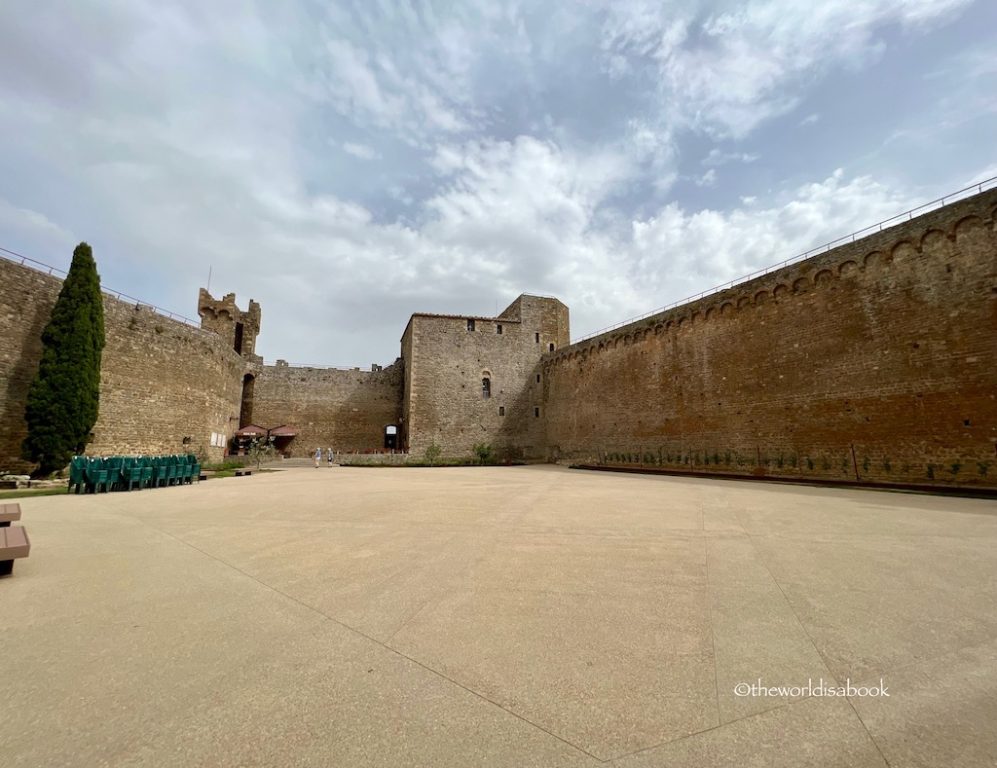
We found one main cobblestoned street that led us to the Piazza del Popolo and Montalcino’s centro storico or old town area. The 14th century Palazzo die Priori clock tower dominated over the square and along the Gothic loggia. Visitors can climb the tower for some panoramic views. We enjoyed wandering around the narrow streets and visiting some of the shops.
Of course, there was no shortage of wine shops where visitors can sample and buy the locally produced Brunello di Montalcino. Yes, most of them will ship to you. This really was a wine town revolving around their most cherished product.
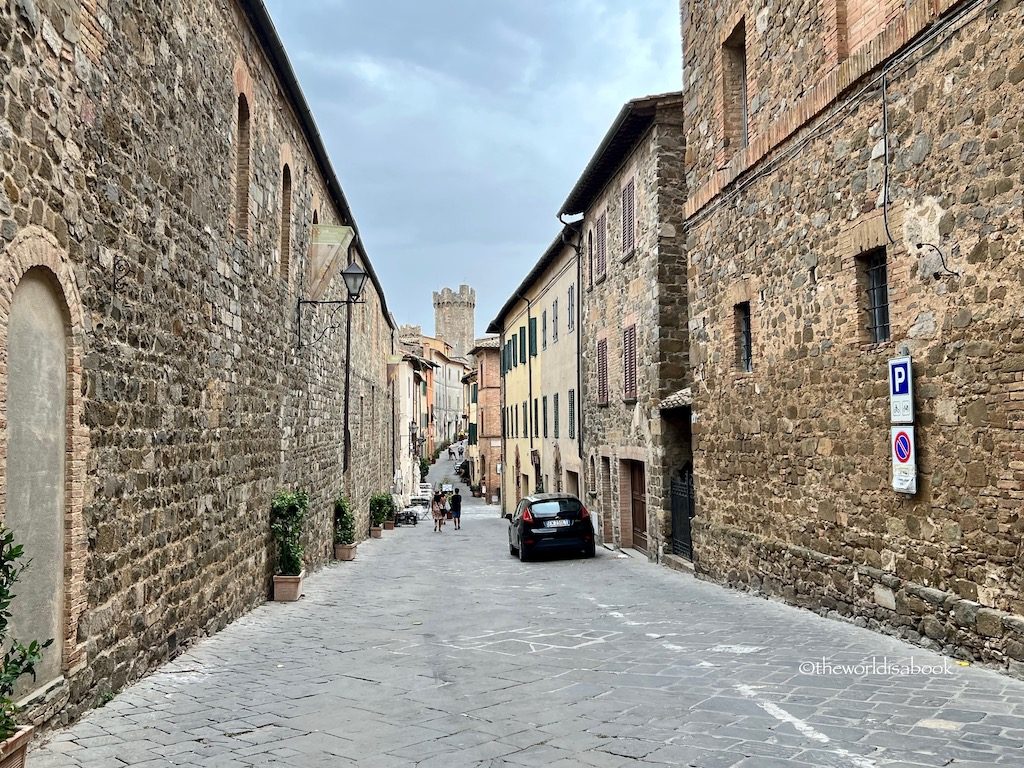
Where to eat
We had an early dinner at one of the few restaurants that was open early here. Caffe Fiaschetteria Italiana Montalcino was a small restaurant with outdoor seating in the shadows of the Palazzo die Priori and they didn’t have a cover charge (somewhat rare in Italy). Their pasta menu was limited but they were delicious especially the tagliatelle. It was a wonderful location with many quaint shops surrounding it.
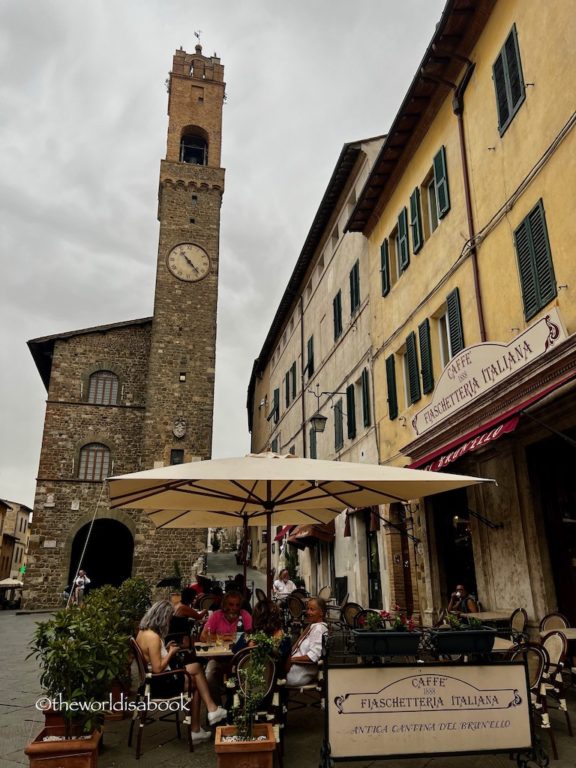
Honestly, this was my least favorite of the Tuscan towns we visited. It was charming and beautiful. But, there was nothing very distinctive about it (besides the fortress) compared to the neighboring towns.
We were here in the late afternoon on a summer weekday and it was pretty empty with hardly any people and activity. My teens were a bit bored after wandering around. If you’re a wine lover, then this town is very appealing.
Day 4: Pienza and Montepulcino
Pienza is an easy day trip from Siena (1 hour) or from Montepulciano (20 minutes). Depending on how early you leave and where you’re staying, you can combine Pienza and Montepulciano in one day which was what we did. It was about an hour from where we were staying in Siena but we started early.
Gladiator area
Before we explored the two towns on our list, my husband (a Gladiator movie fan) found that one of the last and memorable scenes was filmed here near one of the towns we were visiting. If you’ve watched the movie, it is when Maximus went home and walked through the Elysian Fields.
There was a small parking lot across from the Pieve di Corsignano church. We walked on a pathway that led to golden wheat fields and the beautiful countryside. We instantly saw the iconic house and cypress trees on the winding road. The house is on the Manzuoli Farm under Pienza.
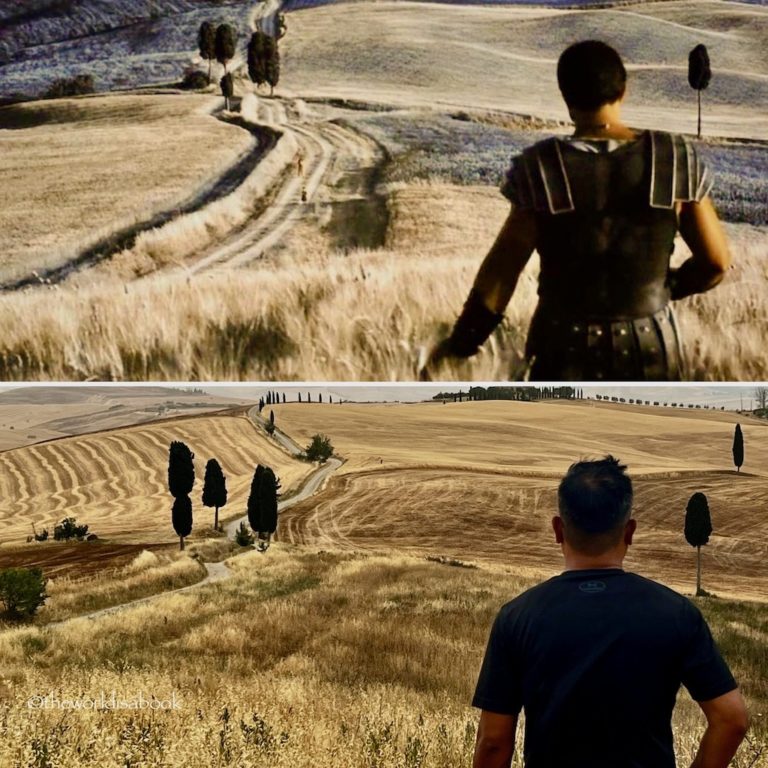
It was funny to see other men there, speaking different languages, doing their photo shoots mimicking the Gladiator scene. This was my husband’s Gladiator scene version.
Use these coordinates: 43.0727996826172, 11.6670799255371
Pienza
This was my favorite town of all the ones we visited in Tuscany. Pienza oozed charm at every corner. It is located about 9 miles (15 km) from Montepulciano and 31 miles (50 Km) from Siena.
Its name comes from Pope Pius II who was born in this town once called Corsignano. Pienza means the “City of Pio”. Pope Pius II wanted to transform his hometown into an ideal model of a Renaissance town. He had the money, influence and resources and made it a reality.
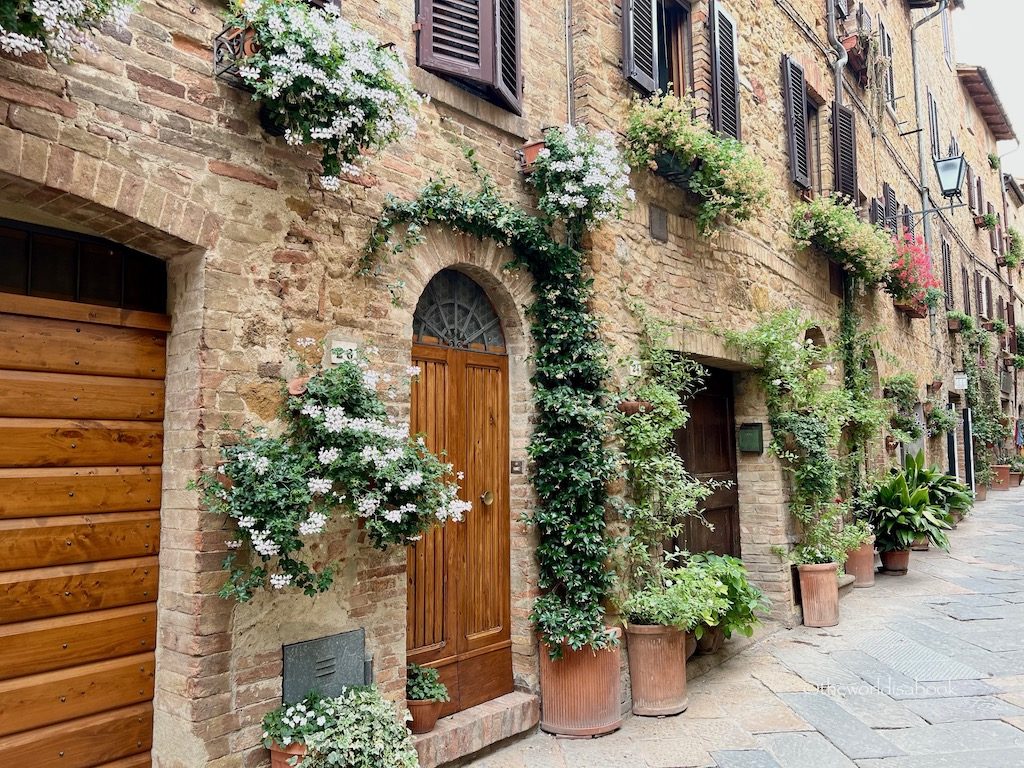
Construction started around 1459 and took about four years to complete. Pienza was used as a model of “humanist urban planning concepts”. Many towns and cities all over Italy have copied and adopted this concept.
It was considered an ideal Renaissance town for its symmetry and harmonious settlement that was built around a central square. Thus, Pienza’s layout has remained the same for centuries.
The Cheese
These days, Pienza is known for its cheese made from sheep’s milk – the Pecorino of Pienza. There were many small artisan shops scattered around the town selling various types of pecorino cheese.
Stop at any one of them for some samplings and tastings. I enjoyed passing by these shops and smelling the distinctive cheese aroma.
Sights/Attractions in Pienza
The main square here is called Piazza Pio II, of course. It was fairly small compared to other European town squares. But, its trapezoid shape was surrounded by historic and important buildings made of travertine stone.
The Duomo or Cattedrale dell’Assunta with a Renaissance exterior and a Gothic interior dominate the square. It was free to go inside the cathedral and well worth a peek to see some impressive artwork especially the altar paintings .
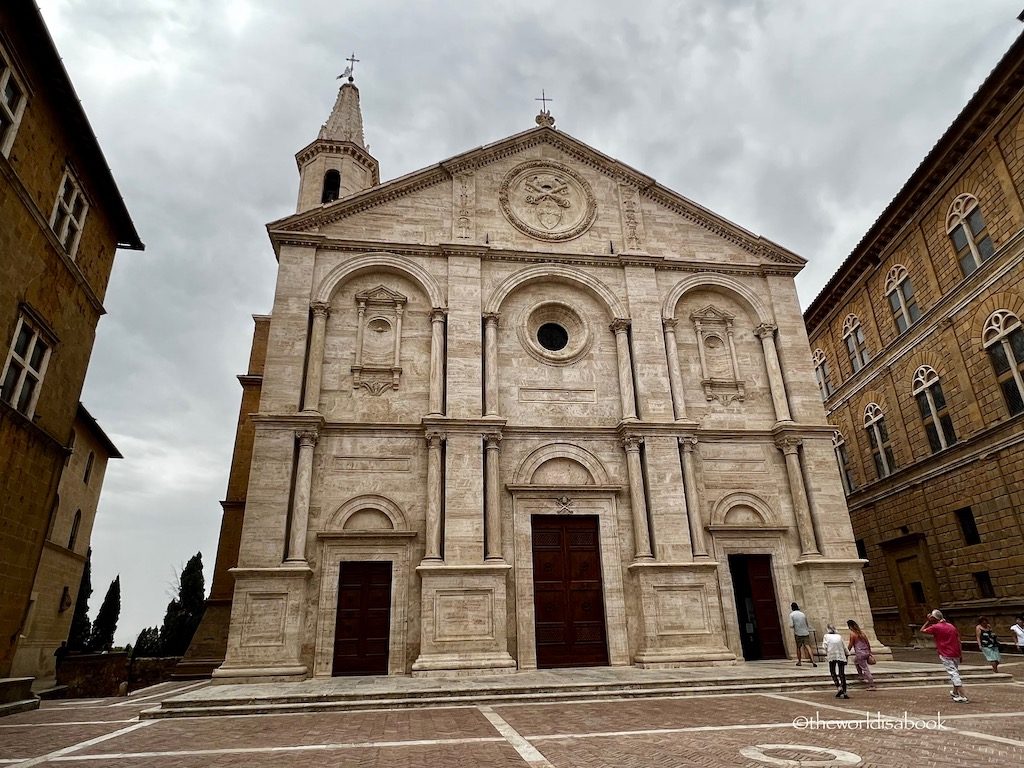
Across from the Duomo was the city hall or Palazzo Comunale. A three-arched loggia anchors the building’s bottom floor, with the council chamber above it.There was also a brick bell tower. A historic travertine well, known as the ‘well of the dogs,’ is also located here.
The Piccolomini Palace to the right of the Duomo has an internal court and three floors of loggia overlooking an enclosed Renaissance garden and Val d’Orcia views. These loggias were common with these palaces to provide covered walkways around enclosed areas.
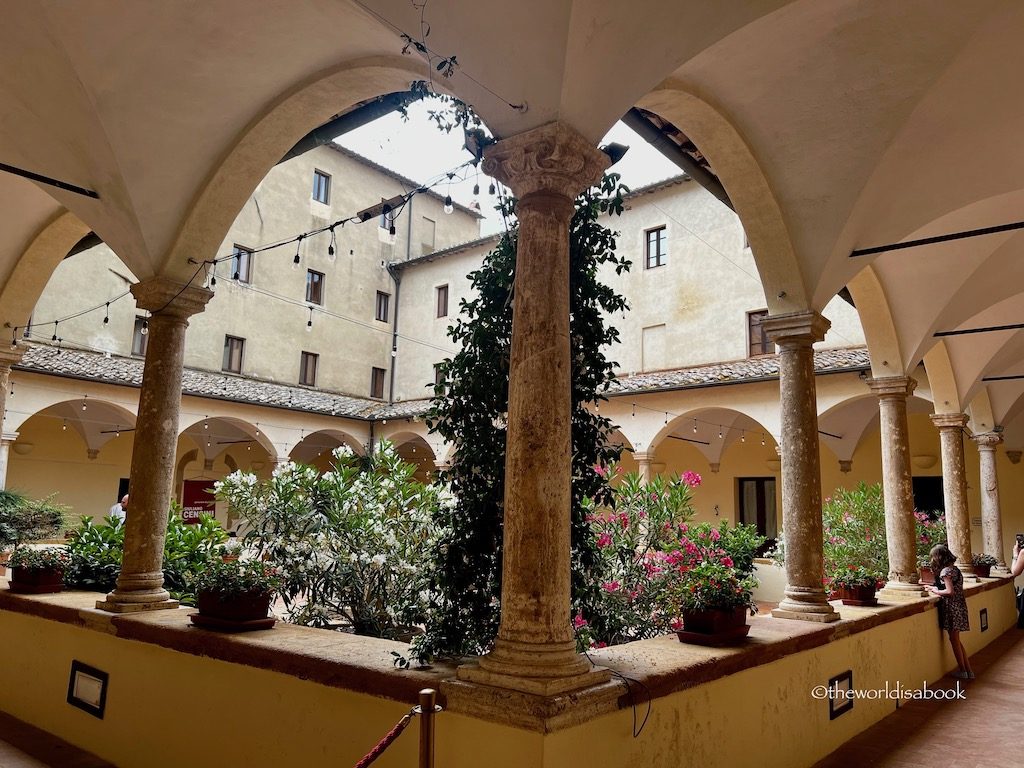
If you have more time and want to delve more into Pienza’s history, you can visit the Diocesan Museum and Museo della Cattedrale housed inside the Palazzo Vescovile. Traveling Bishops who came to visit the Pope used this building. The museums house some important historic and religious artifacts and paintings from the
Don’t forget to walk behind the church. There was a wall and cobblestoned pathway for some fantastic panoramic views of the Orcia Valley.
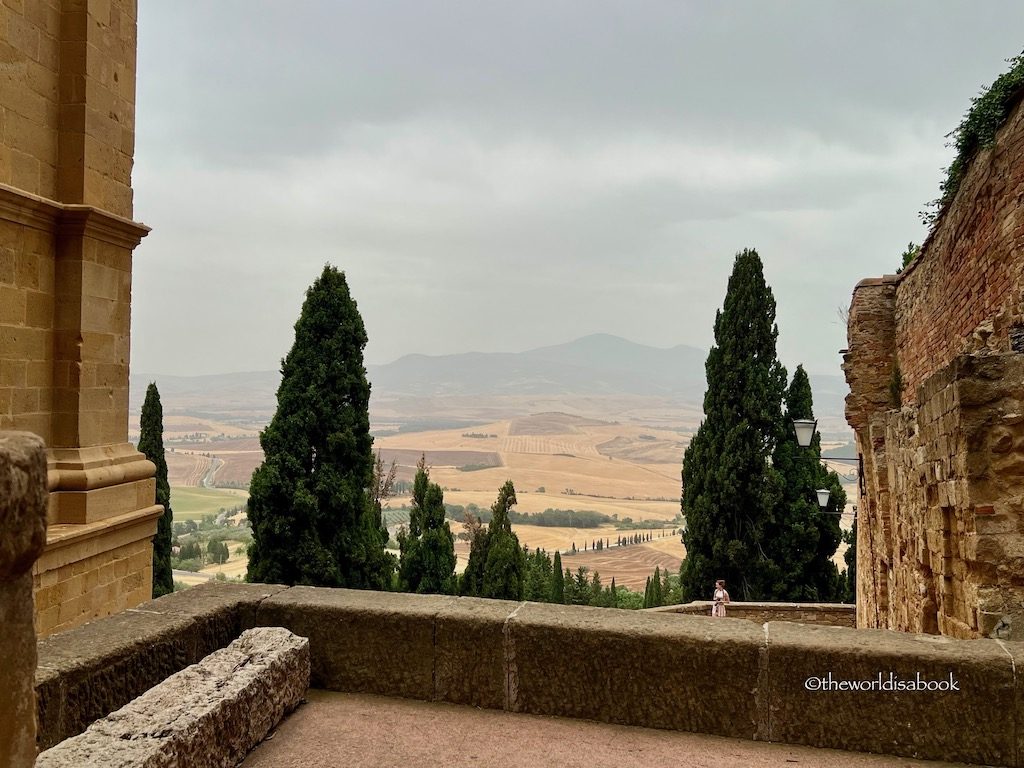
Strolling through Pienza
My favorite part was wandering around and exploring many of the smaller streets and alleys. The town was filled with so many plants from the window boxes brimming with colorful flowers to doors flanked by so much greenery. There were so many planters along the buildings.
These streets were so beautiful with all the flowers and houses adorned with window boxes. These greenery rand color really added some personality and liveliness to all the buildings. Below is a typical narrow street around Pienza brimming with flora,
Where to Eat
We had lunch at Al Fierale Toscana Grill housed in a 16th century building. Its name means “at the fair’ since there was once a square in front of the building with fair livestock.
There’s something so satisfying with tasting food at its source. The Pecorino cheese by itself was delicious! We enjoyed their pasta dishes but be sure to choose some handmade pici pasta smothered with pecorino cheese. There is a good ice cream shop, Buon Gusto Gelateria (Via delle Case Nuove, 26).
Montepulciano
The last Tuscan town we visited was the Renaissance hilltop town of Montepulciano. Many wine experts consider this area as one of the premier winemaking regions. Colorful countryside, rolling hills and a lot of vineyards surrounded the area.
We parked at the small parking lot by the church at the bottom of the hill and entered through a large arch called Porta al Prato. This led us to a pedestrianized area lined with several souvenir shops, restaurants and wineries. The best way to really see Montepulciano is walk and explore the streets and alleys.
Beautiful palaces and churches surrounded Piazza Grande. I really wanted to see this main attraction. It’s no wonder that this piazza was a site of a very popular movie.
If you’re a Twilight movie and book series fan, then you will recognize that some scenes from the movie New Moon. Montepulciano doubled as Volterra which is actually a real town 71 miles from here.
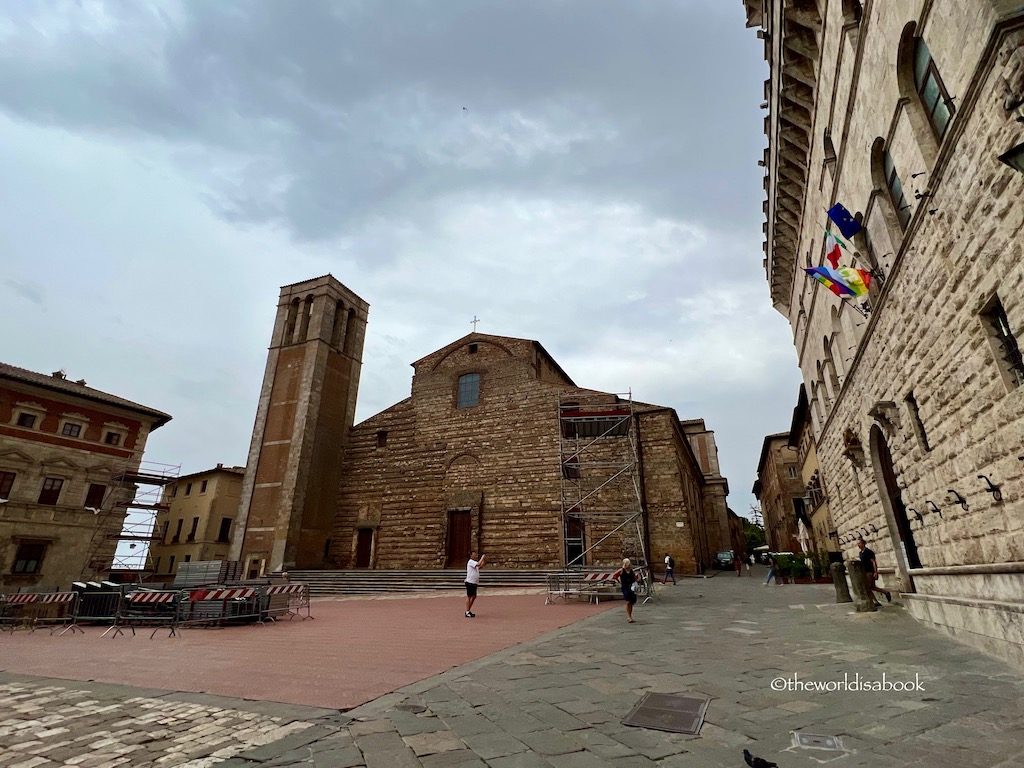
We enjoyed walking through the historic city and even went through a street flanked with colorful flags on our way to the piazza.
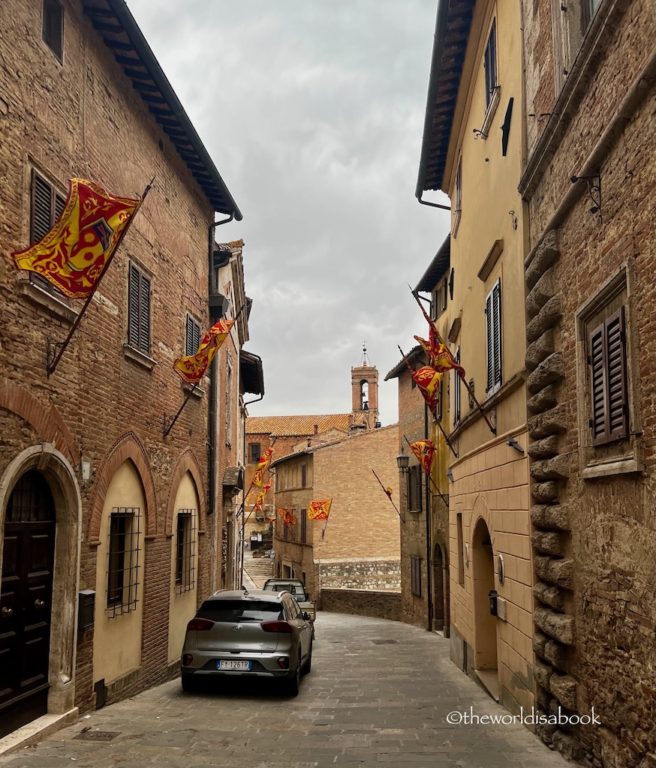
Like many European squares, Montepulciano’s historic center, the Piazza Grande, is the site of many activities. This includes the barrel-racing Bravio delle Botti contest held annually in August.
The Gothic Palazzo Comunale tower, the town hall with its beautiful clock tower, and the 16th-century Cathedral surrounded the piazza. Visitors can also climb the tower for wonderful panoramic views of the surrounding countryside.
Vino Nobile di Montepulciano
In an area of famous Italian wines and a region full of wineries, Montepulciano stands out. Vino Nobile is known worldwide. It is a red wine made from local grapes surrounding the hilltop town.
There is no shortage of wine shops and complimentary wine tastings in Montepulciano. But, it was also interesting to see some underground wine tours here. The locals built several tunnels and wine cellars under the town for aging the Vino Nobile.
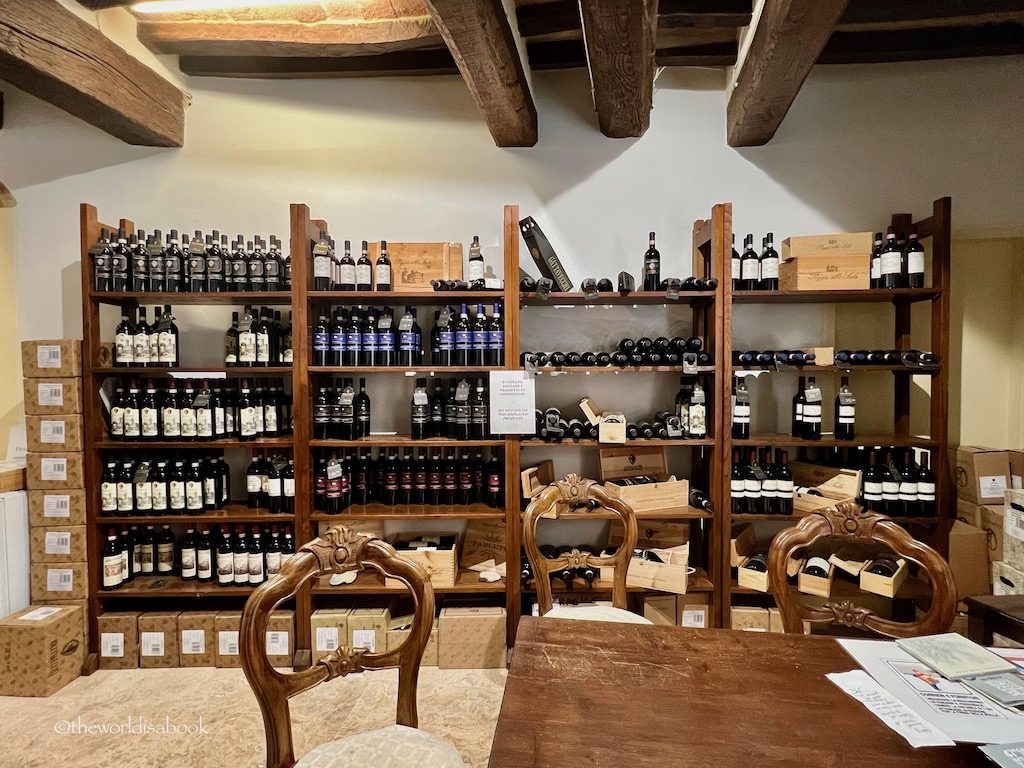
Since we were here with our kids, spending an hour or two doing this particular wine tour didn’t enthuse them too much. So, this is definitely another attraction we need to do when we return sans kids.
Tips for Visiting Val d’Orcia and Tuscany
We highly recommend renting a car. It is the best way to visit these Tuscan towns easily and at your own pace. Buses and trains are not easily accessible or convenient in some of these towns. We rented a car in Florence airport and returned it to Bologna airport. The difference was minimal with the one way drop off. As I stated above, pack some patience during your drive and let the locals pass you or pull over.
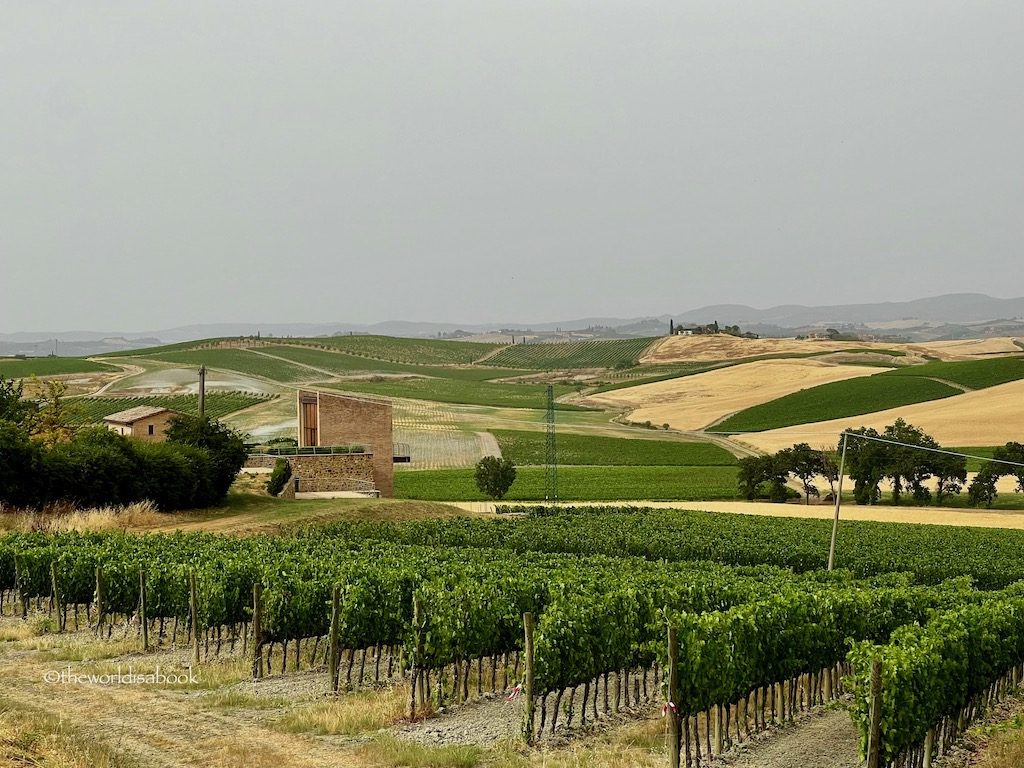
Plan for longer drive times than what your GPS and Google Maps tells you. I guarantee you will be stopping a lot to admire the scenery and take photos.
Be mindful of the ZTL (zona traffico limitato) zones which were very common especially in historic city centers. Usually, only residents or those with permits are allowed to drive within this specific area.
There are plenty of signs to tell you where the boundaries are. Driving in the ZTL zones without the permits can result in some pretty hefty fines.
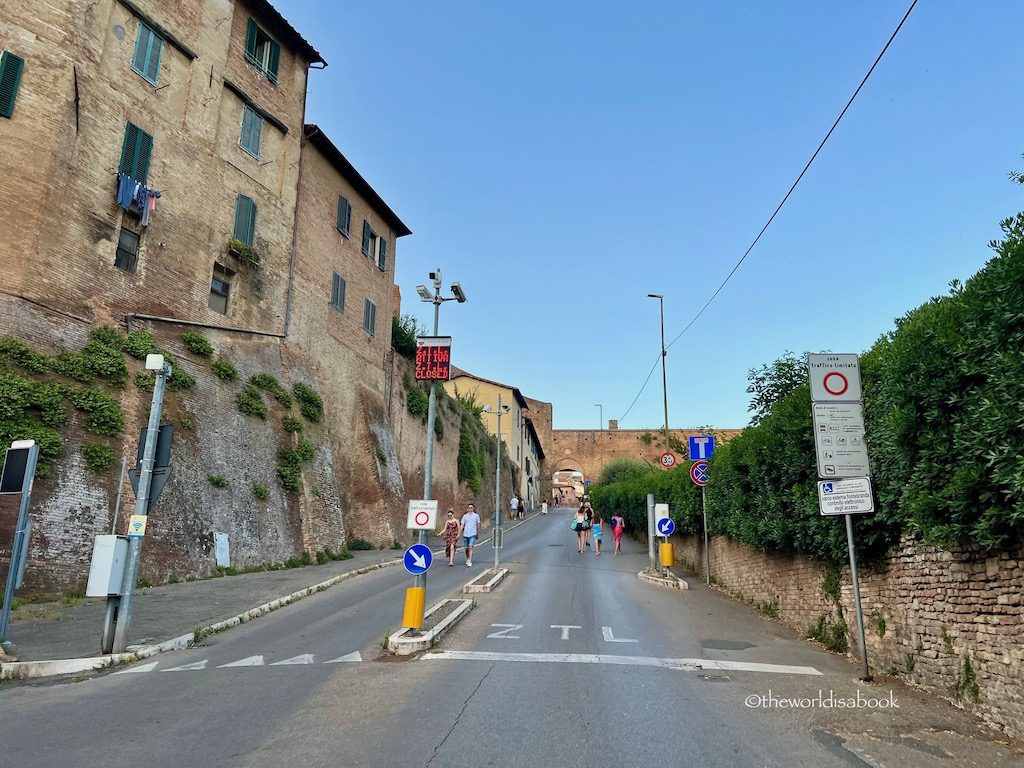
Look into farm stays/agriturismo. While we loved our modern hotel stay in Siena, I would really like to stay at an agriturismo that are fairly common around Tuscany next time.
These are a combination of farms or vineyards with a hotel, aparthotel, bed/breakfast or farmhouse. Some agriturismos offer wonderful amenities from wine or cooking classes to spas.
Take advantage of the spa towns. If you’re visiting the Bagno Vignoni or Bagni San Filippo area, spend some time at the thermal spas like those found at Hotel Adler Thermae or Hotel Posta Marcucci.
Pin it for later!
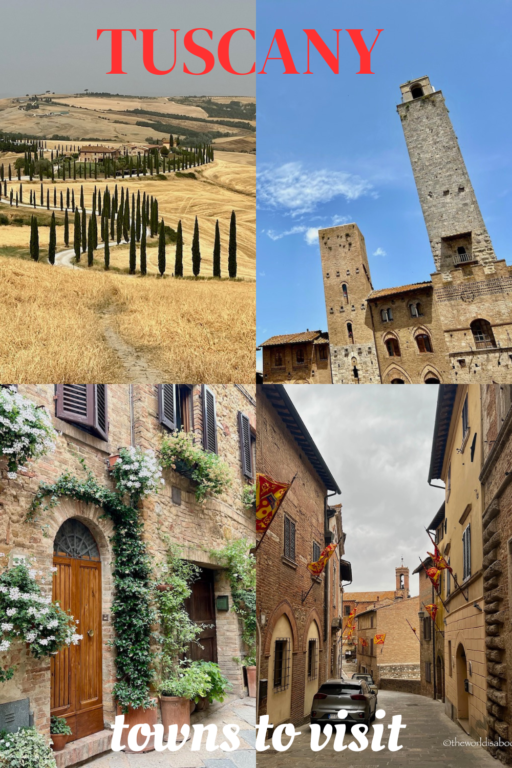
Thank you for such a full write up! A very detailed account. I’ve travelled a lot to Roma and Milan for work and play, and can attest to the craziness of the Italian driver. They are a different breed. Its almost a badge of honour to beep the horn, and to be beeped at. Coming from the airport to Rome for the first time I was wide-eyed and swivel-headed, perplexed at how nonchalant to driver was!